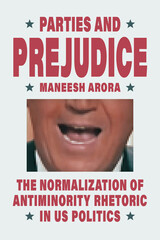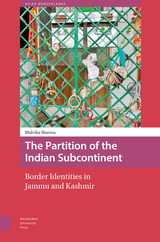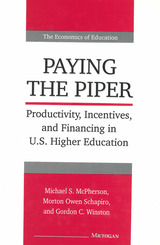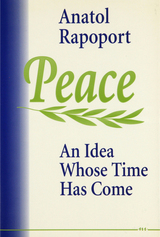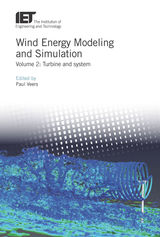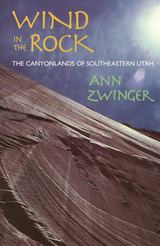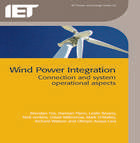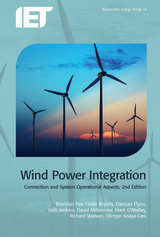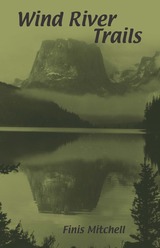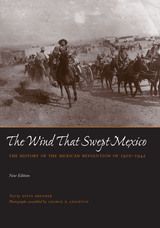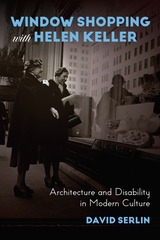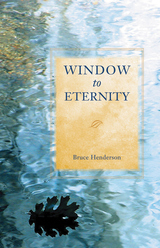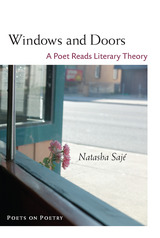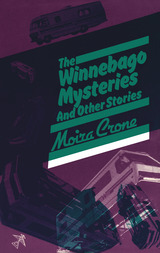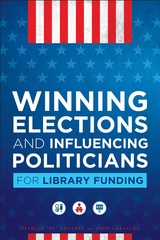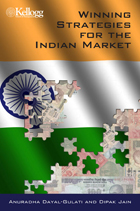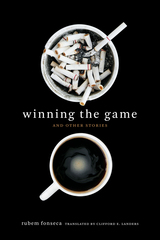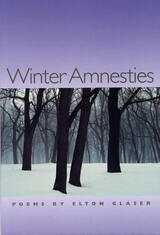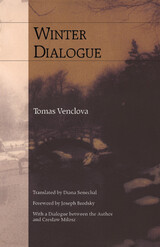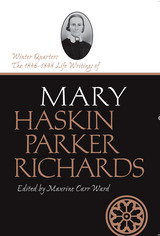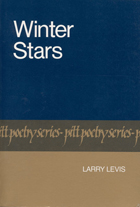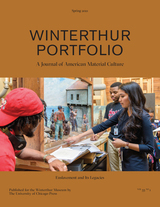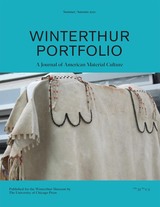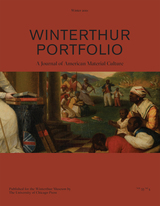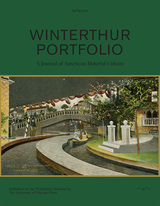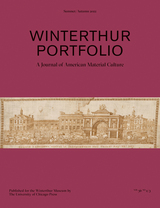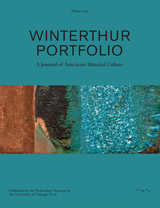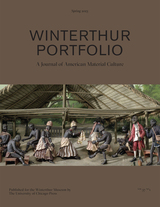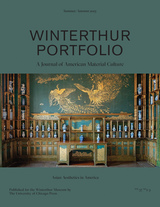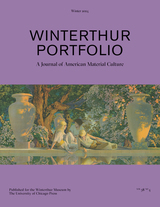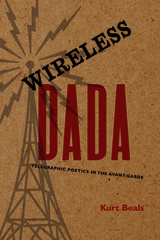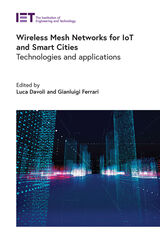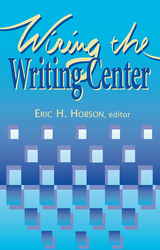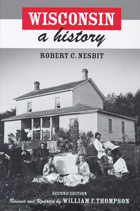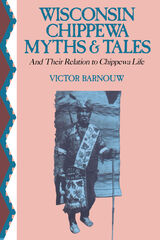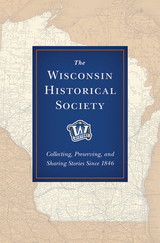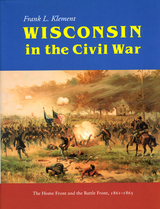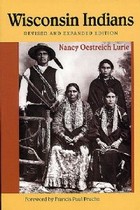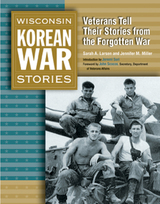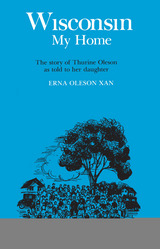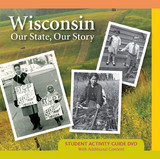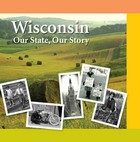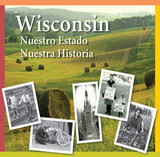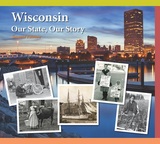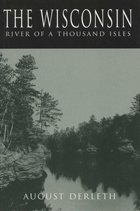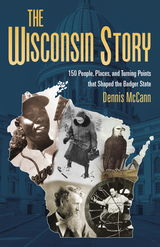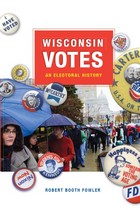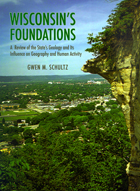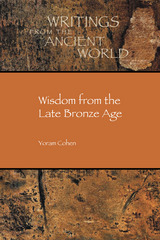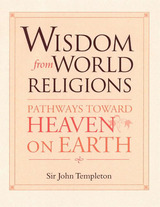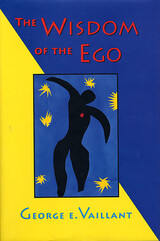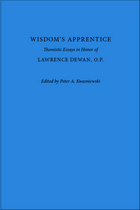Wind Energy Modeling and Simulation: Turbine and system, Volume 2
Paul Veers
The Institution of Engineering and Technology, 2020 In order to optimise the yield of wind power from existing and future wind plants, the entire breadth of the system of a plant, from the wind field to the turbine components, needs to be modelled in the design process. The modelling and simulation approaches used in each subsystem as well as the system-wide solution methods to optimize across subsystem boundaries are described in this reference. Chapters are written by technical experts in each field, describing the current state of the art in modelling and simulation for wind plant design. This comprehensive, two-volume research reference will provide long-lasting insight into the methods that will need to be developed for the technology to advance into its next generation.
Wind in the Rock: The Canyonlands of Southeastern Utah
Ann Zwinger
University of Arizona Press, 1978 Lively, readable nature writing. As she details several treks through the beautiful, rocky canyons, [Zwinger's] feel for the animals and plants native to this arid region enhances the precise sketches which punctuate the text. Readers interested in ancient Indian cultures of the Southwest will also find fascinating reading, as Zwinger describes their campsites and lifestyles. —Library Journal
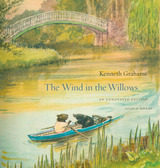 The Wind in the Willows: An Annotated Edition
Kenneth Grahame
Harvard University Press, 2009 Begun as a series of stories told by Kenneth Grahame to his six-year-old son, The Wind in the Willows has become one of the most beloved works of children’s literature ever written. It has been illustrated, famously, by E.H. Shepard and Arthur Rackham, and parts of it were dramatized by A.A. Milne as Toad of Toad Hall. A century after its initial publication it still enchants. Much in Grahame’s novel—the sensitivity of Mole, the mania of Toad, the domesticity of Rat—permeates our imaginative lives (as children and adults). And Grahame’s burnished prose still dazzles. Now comes an annotated edition of The Wind in the Willows by a leading literary scholar that instructs the reader in a larger appreciation of the novel’s charms and serene narrative magic.
In an introduction aimed at a general audience, Seth Lerer tells us everything that we, as adults, need to know about the author and his work. He vividly captures Grahame’s world and the circumstances under which The Wind in the Willows came into being. In his running commentary on the novel, Lerer offers complete annotations to the language, contexts, allusions, and larger texture of Grahame’s prose. Anyone who has read and loved The Wind in the Willows will want to own and cherish this beautiful gift edition. Those coming to the novel for the first time, or returning to it with their own children, will not find a better, more sensitive guide than Seth Lerer.
Wind Power Integration: Connection and system operational aspects
Brendan Fox
The Institution of Engineering and Technology, 2007 The rapid growth of wind generation has many implications for power system planning, operation and control. This would have been a considerable challenge for the old nationalised power companies; it has become an even greater challenge in today's liberalised electricity markets.
Wind Power Integration: Connection and system operational aspects
Brendan Fox
The Institution of Engineering and Technology, 2014 The rapid growth of wind generation has many implications for power system planning, operation and control. Network development, voltage rise, protection, monitoring and control are connection problems common to all wind power generation.
Wind Power Modelling: Power plants and grid integration, Volume 3
Paul Veers
The Institution of Engineering and Technology, 2019 Wind Power Modelling: Power plants and grid integration is the third book in a comprehensive three-volume set on wind farm power modelling; the key to efficient wind plant design and wind power growth. The set covers every aspect - from wind flow over turbine component design to grid integration. With chapters from eminent international experts, the set is written for researchers in academia and industry involved with all facets of wind power modelling. Covering generation, storage technologies and grid models, this volume will be of particular interest to practitioners in the utilities sector.
Wind River Trails
Finis Mitchell
University of Utah Press, 1999 Mitchell draws on decades of experience to describe the trails, routes, wildlife, glaciers, lakes, and streams in Wyoming's fabulous two-and-a-quarter million acre Wind River Range. A short hike was the beginning of a long career in wilderness living for Finis Mitchell of Rock Springs, Wyoming. He has scaled 244 peaks, including four times to the trop of Gannett Peak, the highest mountain in the state. A vigorous supporter of wilderness, the mountain man pours out his philosophy at meetings and slide shows with amazing attention to detail. He has taken 105,345 pictures as a hobby and uses them in his slide shows to show people their own public lands. He has drawn on his vast experience in the Wind Rivers to describe, in this guide book, the trails, routes, wildlife, glaciers, 4,000 lakes and 800 miles of streams in Wyoming’s fabulous two and a quarter million acre Wind River Range.
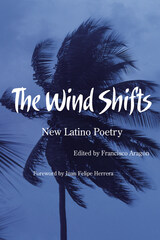 The Wind Shifts: New Latino Poetry
Edited by Francisco Aragón; Foreword by Juan Felipe Herrera
University of Arizona Press, 2007 The Wind Shifts gathers, for the first time, works by emerging Latino and Latina poets in the twenty-first century. Here readers will discover 25 new and vital voices including Naomi Ayala, Richard Blanco, David Dominguez, Gina Franco, Sheryl Luna, and Urayoán Noel. All of the writers included in this volume have published poetry in well-regarded literary magazines. Some have published chapbooks or first collections, but none had published more than one book at the time of selection. This results in a freshness that energizes the enterprise.
Certainly there is poetry here that is political, but this is not a polemical book; it is a poetry book. While conscious of their roots, the artists are equally conscious of living in the contemporary world—fully engaged with the possibilities of subject and language. The variety is tantalizing. There are sonnets and a sestina; poems about traveling and living overseas; poems rooted in the natural world and poems embedded in suburbia; poems nourished by life on the U.S.–Mexico border and poems electrified by living in Chicago or Los Angeles or San Francisco or New York City.
Some of the poetry is traditional; some is avant-garde; some is informed by traditional poetry in Spanish; some follows English forms that are hundreds of years old. There are love poems, spells that defy logic, flashes of hope, and moments of loss. In short, this is the rich and varied poetry of young, talented North American Latinos and Latinas.
The Wind that Swept Mexico: The History of the Mexican Revolution of 1910-1942
Text by Anita Brenner
University of Texas Press, 1971 The Mexican Revolution began in 1910 with the overthrow of dictator Porfirio Díaz. The Wind That Swept Mexico, originally published in 1943, was the first book to present a broad account of that revolution in its several different phases. In concise but moving words and in memorable photographs, this classic sweeps the reader along from the false peace and plenty of the Díaz era through the doomed administration of Madero, the chaotic years of Villa and Zapata, Carranza and Obregón, to the peaceful social revolution of Cárdenas and Mexico's entry into World War II. The photographs were assembled from many sources by George R. Leighton with the assistance of Anita Brenner and others. Many of the prints were cleaned and rephotographed by the distinguished photographer Walker Evans.
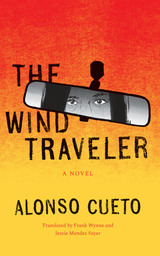 The Wind Traveler: A Novel
By Alonso Cueto; translated by Frank Wynne and Jessie Mendez Sayer
University of Texas Press, 2020 The Wind Traveler showcases the mesmerizing storytelling of Alonso Cueto at the top of his career. At the heart of his latest work is a seemingly ordinary man named Ángel, who sells kitchenware at a store in Lima. In the early 1990s, he had served as an army soldier, engaging in brutal acts whose aftermath still reverberates. He is forced to reckon with his past when a woman he was instructed to kill enters the store and buys a few items. How can she still be alive? What's more, how can she not recognize Ángel? Remarkably, she asks him to deliver her purchases to her house. From this moment, Ángel feels compelled to make amends through any means necessary, even if it requires sacrificing his life of quiet retirement. A stirring tribute to the wounded souls who yearn to make peace with the past, The Wind Traveler offers a new vision of the fragile human connections that sustain a deeply fractured world.
Wind Turbine System Design: Electrical systems, grid integration, control and monitoring, Volume 2
Jan Wenske
The Institution of Engineering and Technology, 2024 Wind energy is a pillar of the strategy for mitigating greenhouse gas emissions and staving off catastrophic climate change, but the market is under tremendous pressure to reduce costs. This results in the need for optimising any new wind turbine to maximise the return on investment and keep the technology profitable and the sector thriving. Optimisation involves selecting the best component out of many, and then optimising the system as a whole.
Wind Turbine System Design: Nacelles, drivetrains and verification, Volume 1
Jan Wenske
The Institution of Engineering and Technology, 2022 Wind energy is a pillar of the strategy to mitigate greenhouse gas emissions and stave off catastrophic climate change, but the market is under tremendous pressure to reduce costs. This results in the need for optimising any new wind turbine to maximise the return on investment and keep the technology profitable and the sector thriving. Optimisation involves selecting the best component out of many, and then optimising the system as a whole. Key components are the nacelles and drive trains, and the verification of their work as a system.
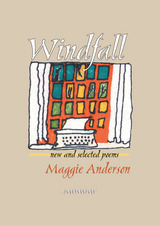 Windfall: New and Selected Poems
Maggie Anderson
University of Pittsburgh Press, 2000 Windfall includes poems from three previous books by Maggie Anderson, along with a generous selection of new work. In this collection we can see over two decades of the growth of a poet memorable for the clarity, strength, and urgency of her voice. Anderson’s poems entangle a language, a history, and a group of belongings, and she is both at home and a foreigner in the places she invokes. Every place in these poems seems inhabitable, yet the tensions of these deceptively quiet lines develop out of the clear reluctance or inability of the poet to sit still. Maggie Anderson writes out of deep grief for the political losses of work and money, of life and limb and home in our dangerous times. She remembers and witnesses, and she also speaks eloquently for our private griefs—the loss of family, vitality and self. These poems do not shout; we listen as if following a whisper in the dark. A counterpoint to the sorrows in these poems is a complex and often joyous music, as well as a wry, sometimes self-deprecating humor which saves the work from solemnity. Her rhythms are diverse and intricate; they move deftly from fiddle whine to saxophone, from fugue to blues.
 Wind–Mountain–Oak: The Poems of Sappho
Dan Beachy-Quick
Tupelo Press, 2023 Dan Beachy-Quick writes, “There are depths within the denotative life of Greek words that English seldom allows readers in translation to access. At some basic level, I wanted to offer a translation that traced out some of those complexities into an apprehendable substance in the poems themselves—sometimes by allowing an image to unfold more fully than is the norm, at other times by giving some sense of a word’s complicated life, the compound nature of the Greek language, or by translating the same line in multiple ways. The hope, far-fetched as it might be, is to give a reader in English some semblance of how an ancient Greek listener might hear these songs. I’ve also veered away from the various traditions of ordering the poems. I’ve clustered them into groups that seem to loosely trace the entirety of life, from childhood to older age, from the birth of desire to the fear of no longer being desirable. In a quiet way, I mean the book to read as a kind novel, a bildungsroman, so that a larger sense of the life—the poem of the life—becomes palpable. “
Window Shopping with Helen Keller: Architecture and Disability in Modern Culture
David Serlin
University of Chicago Press, 2025 A particular history of how encounters between architects and people with disabilities transformed modern culture.
Window Shopping with Helen Keller recovers a series of influential moments when architects and designers engaged the embodied experiences of people with disabilities. David Serlin reveals how people with sensory and physical impairments navigated urban spaces and helped to shape modern culture. Through four case studies—the lives of Joseph Merrick (aka “The Elephant Man”) and Helen Keller, the projects of the Works Progress Administration, and the design of the Illinois Regional Library for the Blind and Physically Handicapped—Serlin offers a new history of modernity’s entanglements with disability.
Window to Eternity
BRUCE HENDERSON
Swedenborg Foundation Publishers, 2010 What happens to us when we die? Is there really a heaven and hell? Are there angels watching over us? These questions follow us from early childhood to old age, particularly in moments when we’re confronted with the loss of a loved one. In Window to Eternity, Bruce Henderson draws from the teachings of visionary Emanuel Swedenborg to paint a vivid picture of heaven and hell, where the souls of the departed become angels and demons and indescribable wonders await. But far from being a distant destination, Henderson shows that heaven is a choice that each of us makes every day—ours to have or to turn away from, regardless of our background or religious upbringing.
Windows and Doors: A Poet Reads Literary Theory
Natasha Saje
University of Michigan Press, 2014 Windows and Doors is a poetry handbook that places poststructuralist and postmodern ways of thinking alongside formalist modes, making explicit points of overlap and tension that are usually tacit. Each of Natasha Sajé’s nine essays addresses a topic of central concern to readers and writers of poetry while also making an argument about poetic language and ideology. Foundational topics—diction, syntax, rhythm, surprise, figurative language, narrative, genre, book design, and performance—are explained through the lenses of theory, history, and philosophy and illuminated through vibrant examples from the works of numerous contemporary American poets.
 Windows into the Past: Life Histories and the Historian of South Asia
Judith M. Brown
University of Notre Dame Press, 2009
Judith M. Brown, one of the leading historians of South Asia, provides an original and thought-provoking strategy for conducting and presenting historical research in her latest book, Windows into the Past. Brown looks at how varieties of "life history" that focus on the lives of institutions and families, as well as individuals, offer a broad and rich means of studying history. Her distinctively creative approach differs from traditional historical biography in that it explores a variety of "life histories" and shows us how they become invaluable windows into the past.
Following her introduction, "The Practice of History," Brown opens windows on the history of South Asia. She begins with the life history of an educational institution, Balliol College, Oxford, and tracks the interrelationship between Britain and India through the lives of the British and Indian men who were educated there. She then demonstrates the significance of family life history, showing that by observing patterns of family life over several generations, it is possible to gain insight into the experiences of groups of people who rarely left historical documents about themselves, particularly South Asian women. Finally, Brown uses the life history of two prominent individuals, Mahatma Gandhi and Jawaharlal Nehru, to examine questions about the nature of Indian nationalism and the emergent Indian state.
"This book provides an example of the historian's craft at its best. Known throughout the world for her balanced and influential interpretation of modern India, Mahatma Gandhi, and Nehru, Judith Brown has excelled herself by opening windows into India's recent past that hitherto have remained closed. The elegance of style adds to the power of the argument. Read it: you will enjoy the experience." --Anthony Parel, University of Calgary
"Once again, Judith Brown has amazed us with something truly remarkable. Her latest book, so exquisitely well crafted, is a gem. It gives us fresh glimpses into facets of India's (or South Asia's) recent past, of things never before seen, or imagined. Reflecting brilliance of imagination and insight, it shows us new ways of 'doing history.' By focusing upon dynastic 'lives' of specific institutions--cohorts and families of Balliol College, as well as individuals in their 'public' and 'private' worlds--this work turns our understandings around. Never again will we look at the Raj, or at Gandhi and Nehru, in quite the same way." --Robert Eric Frykenberg, University of Wisconsin-Madison
"Utilizing Balliol College records, personal photographs, life histories, and more traditional sources such as autobiographies and private papers, Judith Brown incisively explores multiple themes in the history of colonial and independent India. They range from the graduates of Balliol College who formed 'dynasties' within an imperial administration to how the iconic Indian leaders, Gandhi and Nehru, confronted public and private challenges while creating an Indian nation. Her fascinating narrative of family histories will stimulate both professional historians and popular audiences to reconsider how such histories can illuminate broader topics such as imperial dominance, nation-building, and globalization." --Barbara Ramusack, Charles Phelps Taft Professor, University of Cincinnati
"Judith Brown provides an insightful demonstration of the diverse uses historians can make of biography as a means of interrogating the past and of communicating with a wider public outside academia. In taking 'life history' beyond the study of individuals to explore family, group, and institutional trajectories over several generations, Brown's innovative analyses extend from the lives of powerful and well-documented figures central to the evolution of modern India, particularly Gandhi and Nehru, to British family 'dynasties' and educational institutions that decisively shaped the Raj to the lives of ordinary Indian women and men who left few written traces. Her work positions South Asia and its peoples, particularly its imperial and international migrants and diasporas, within a suggestively global framework." --Elizabeth Buettner, University of York
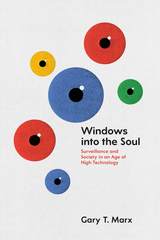 Windows into the Soul: Surveillance and Society in an Age of High Technology
Gary T. Marx
University of Chicago Press, 2016 We live in an age saturated with surveillance. Our personal and public lives are increasingly on display for governments, merchants, employers, hackers—and the merely curious—to see. In Windows into the Soul, Gary T. Marx, a central figure in the rapidly expanding field of surveillance studies, argues that surveillance itself is neither good nor bad, but that context and comportment make it so. In this landmark book, Marx sums up a lifetime of work on issues of surveillance and social control by disentangling and parsing the empirical richness of watching and being watched. Using fictional narratives as well as the findings of social science, Marx draws on decades of studies of covert policing, computer profiling, location and work monitoring, drug testing, caller identification, and much more, Marx gives us a conceptual language to understand the new realities and his work clearly emphasizes the paradoxes, trade-offs, and confusion enveloping the field. Windows into the Soul shows how surveillance can penetrate our social and personal lives in profound, and sometimes harrowing, ways. Ultimately, Marx argues, recognizing complexity and asking the right questions is essential to bringing light and accountability to the darker, more iniquitous corners of our emerging surveillance society. For more information, please see www.garymarx.net.
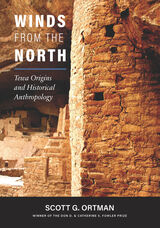 Winds from the North: Tewa Origins and Historical Anthropology
Scott G. Ortman
University of Utah Press, 2012 Winner of the Don D. and Catherine S. Fowler Prize
The “abandonment” of Mesa Verde and the formation of the Rio Grande Pueblos represent two classic events in North American prehistory. Yet, despite a century of research, no consensus has been reached on precisely how, or even if, these two events were related. In this landmark study, Scott Ortman proposes a novel and compelling solution to this problem through an investigation of the genetic, linguistic, and cultural heritage of the Tewa Pueblo people of New Mexico. Integrating data and methods from human biology, linguistics, archaeology, and cultural anthropology, Ortman shows that a striking social transformation took place as Mesa Verde people moved to the Rio Grande, such that the resulting ancestral Tewa culture was a unique hybrid of ideas and practices from various sources. While addressing several long-standing questions in American archaeology, Winds from the North also serves as a methodological guidebook, including new approaches to integrating archaeology and language based on cognitive science research. As such, it will be of interest to researchers throughout the social and human sciences.
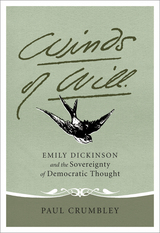 Winds of Will: Emily Dickinson and the Sovereignty of Democratic Thought
Paul Crumbley
University of Alabama Press, 2010 In this study, Paul Crumbley asserts that, contrary to popular opinion, Emily Dickinson consistently communicated political views through her poetry. Dickinson’s life of self-isolation—today her most notable personal characteristic—by no means extended into the political sphere, he argues. While she rarely addressed political issues directly and was curiously disengaged from the liberal causes and female reform movements of her time, Dickinson’s poems are deeply rooted both in matters of personal sovereignty and reader choice. The significant choices Dickinson extends to the reader underscore the democratic dimensions of reading her work, and of reading itself as a political act. Crumbley employs close readings of Dickinson’s poems and letters, highlighting the many changing—and often contradictory—voices in her work, both throughout her oeuvre and in individual poems themselves. In Dickinson’s letters Crumbley finds just as many unique and conflicting voices; thus, both her personal correspondence and the poems make political demands by placing the burden of interpretation on the reader. Rather than reflecting explicit political values, Dickinson’s work chronicles an ongoing decision-making process that magnifies the role of individual choice, not the advocacy of specific outcomes. In the end, Dickinson’s readers must either accept an isolated lyric subjectivity or invest that subjectivity with the substance necessary for engagement with the larger world.
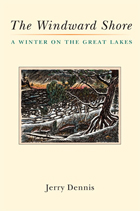 The Windward Shore: A Winter on the Great Lakes
Jerry Dennis
University of Michigan Press, 2012 If you have been enchanted by Jerry Dennis’s earlier work on sailing the Great Lakes, canoeing, angling, and the natural wonders of water and sky—or you have not yet been lucky enough to enjoy his engaging prose—you will want to immerse yourself in his powerful and insightful new book on winter in Great Lakes country. Grounded by a knee injury, Dennis learns to live at a slower pace while staying in houses ranging from a log cabin on Lake Superior’s Keweenaw Peninsula to a $20 million mansion on the northern shore of Lake Michigan. While walking on beaches and exploring nearby woods and villages, he muses on the nature of time, weather, waves, agates, books, words for snow and ice, our complex relationship with nature, and much more. From the introduction: “I wanted to present a true picture of a complex region, part of my continuing project to learn at least one place on earth reasonably well, and trusted that it would appear gradually and accumulatively—and not as a conventional portrait, but as a mosaic that included the sounds and scents and textures of the place and some of the plants, animals, and its inhabitants. Bolstered by the notion that a book is a journey that author and reader walk together, I would search for promising trails and follow them as far as my reconstructed knee would allow.”
Windy McPherson's Son
Sherwood Anderson
University of Illinois Press, 1993 Sherwood Anderson's first and most autobiographical novel and the only one set in Illinois, Windy McPherson's Son received uniformly high praise from literary critics when it was first published. It tells the story of an Iowa newsboy who fights his way to fortune in Chicago, then questions the meaning of his success. It was republished in 1922 with a different ending, which appears as an appendix in this edition.
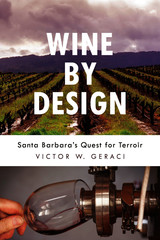 Wine By Design: Santa Barbara's Quest for Terroir
Victor W. Geraci
University of Nevada Press, 2020 From its eighteenth-century beginnings, the Santa Barbara wine industry achieved success by embracing a “wine by design” model. In this process farmers, winemakers, and entrepreneurs overcome roadblocks like diseases, government policies and regulations, and environmental concerns by utilizing the latest technological advances coupled with agribusiness capitalism.
As the American demand for premium wine grapes intensified in the late twentieth century, the Northern California wine industry rapidly grew its boutique and innovative local designer winemaking to increase profit to meet demand and compete on a global scale. Set in the context of the regional, national, and global wine community, this story illuminates a regional story of how the Santa Barbara wine industry found solutions to current market conditions while utilizing local traditions to develop a new version of local wine terroir. An accomplishment that allowed them to compete in the global marketplace yet develop highly specialized wine that is unique to the region.
By employing leading-edge technology and entrepreneurship, the California Central Coast region of Santa Barbara became a model for the American vision of agricultural innovation and an integral part of the international wine trade, developing a personalized version of local wine terroir.
 The Wine of Eternity: Short Stories from the Latvian
Knuts Lesins
University of Minnesota Press, 1957 The Wine of Eternity was first published in 1957. Minnesota Archive Editions uses digital technology to make long-unavailable books once again accessible, and are published unaltered from the original University of Minnesota Press editions. Ever since the small Baltic nation of Latvia became a part of the Soviet Union in 1940, its identity has been blurred to Western eyes. Many of its people have left their country in voluntary or forced exile. But, wherever they are today, the Latvians still cherish and preserve a rich national heritage of folklore and culture. Much of this is revealed in these stories, the work of an established Latvian writer who became a wartime refugee from his country. This volume makes the work of Knuts Lesins available in English for the first time, although his writing has been published extensively in Europe in the original Latvian. In addition to the stories, the author provides a background sketch of the history and culture of Latvia. While much of the fascinating folklore of the country is interwoven in the stories, they are not primarily folk tales. They are perhaps best described as penetrating glimpses into human lives at moments of crisis or decision which reveal an individual's character and philosophy.
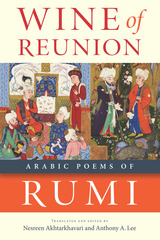 Wine of Reunion: Arabic Poems of Rumi
Rumi
Michigan State University Press, 2017 Exciting to those unfamiliar with Rumi’s verse as well as to the veteran scholar, this volume, following on Love Is My Savior, offers more of the little-known Arabic poems of Mawlana Rumi. These poems take the reader on a journey of spiritual search, ecstatic union, universal salvation, and mystic reconciliation, in which Rumi reveals his soul and welcomes everyone to his spiritual feast. This dual-language volume, with its informative introduction, is one of the first to bring Rumi’s Arabic poems into English, and it opens a treasury of Rumi’s mystic thought and electrifying poetry. The poems pulsate with desire and longing, with erotic meaning, and with ecstatic celebration. Rumi found in his mystic poetry a vehicle for the expression of the endless spiritual bounties of love. The reader will find, at the center of his faith and doctrine, love and a strong belief in universal salvation and unlimited generosity.
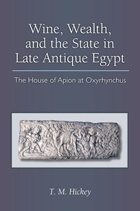 Wine, Wealth, and the State in Late Antique Egypt: The House of Apion at Oxyrhynchus
T. M. Hickey
University of Michigan Press, 2012 The "glorious house" of the senatorial family of the Flavii Apiones is the best documented economic entity of the Roman Empire during the fifth through seventh centuries, that critical period of transition between the classical world and the Middle Ages. For decades, the rich but fragmentary manuscript evidence that this large agricultural estate left behind, preserved for 1,400 years by the desiccating sands of Egypt, has been central to arguments concerning the agrarian and fiscal history of Late Antiquity, including the rise of feudalism. Wine, Wealth, and the State in Late Antique Egypt is the most authoritative synthesis concerning the economy of the Apion estate to appear to date. T. M. Hickey examines the records of the family's wine production in the sixth century in order to shed light on ancient economic practices and economic theory, as well as on the wine industry and on estate management. Based on careful study of the original manuscripts, including unpublished documents from the estate archive, he presents controversial conclusions, much at odds with the "top down" models currently dominating the scholarship.
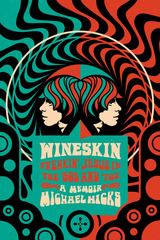 Wineskin: Freakin’ Jesus in the ‘60s and ‘70s
Michael Hicks
Signature Books, 2022 Mormonism begins with a memoir: Joseph Smith kneeling in a grove until two-thirds of the Godhead appear and promise him a quixotic religious renown. Since then, the faith Smith birthed has raised up memoirs as gritty as Parley P. Pratt’s quasi-canonical Autobiography or as luminously sarcastic as Elna Baker’s New York Regional Mormon Singles Halloween Dance. Grafted somewhere into those works’ genealogy comes this boyhood memoir, rooted not in Mormonism but in the Protestantism of American suburbia and the Jesus Freak movement of the early 1970s, then in, out, and back into the Church of Jesus Christ of Latter-day Saints.
Michael Hicks’s story is a tale studded with awkward episodes of sex, drugs, and rock and roll (not necessarily in that order), along with alcohol, sci-fi, theft, radical politics, cartooning, halfway houses, and the musical avant-garde. The one constant is the brooding figure of Jesus Christ behind Hicks’s various personal reclamations and metamorphoses, often via methods admittedly off the books. While many readers know Hicks as a Mormon academic—thirty-five years a professor of music at Brigham Young University—Wineskin excavates the path, from boyhood to a PhD, that led him toward a faith that is both primitively Christian and highmindedly Mormon.
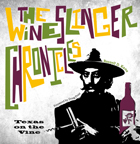 The Wineslinger Chronicles: Texas on the Vine
Russell D. Kane, with foreword by Doug Frost
Texas Tech University Press, 2012 In his pursuit of Texas terroir, the sense of place manifest in Texas wine country’s sun-baked soils, variable climate, and human intervention, Russell Kane has traveled the state tasting wine, interviewing the major players in Texas wine culture, and reflecting on the state’s extraordinary history and enterprising peoples. Here is the total immersion experience. Texas Wineslinger, the moniker now synonymous with Kane, sprouted from a blog of an Australian wine writer after Kane compared the big red wines that originate from the red sand and porous limestone common to both the Texas High Plains and Australia’s Coonawarra wine region. Kane’s reflections include explorations of Spanish missionary life and the sacramental wine made from Texas’s first vineyard as well as the love for grapes and wine brought subsequently by German and Italian immigrants from their homelands. Kane also relates stories of the modern-day growers and entrepreneurs who overcame the lingering effects of temperance and prohibition—forces that failed to eradicate Texas’s destiny as an emerging wine-producing region. A postscript, “A Winegrower’s Prayer,” serves as a poignant reminder of the challenges that weigh heavy on those still defining the terroir of Texas’s wine frontier.
 The Wing of Madness: The Life and Work of R.D. Laing
Daniel Burston
Harvard University Press, 1996 Daniel Burston chronicles Laing's meteoric rise to fame as one of the first media psychogurus of the century, and his spiraling decline in the late seventies and eighties. Here are the successes: Laing's emergence as a unique voice on the psychiatric scene with his first book, The Divided Self, in 1960; his forthright and articulate challenges to conventional wisdom on the origins, meaning, and treatment of mental disturbances; his pioneering work on the families of schizophrenics, Sanity, Madness and the Family (coauthored with A. Esterson). Here as well are Laing's more dubious moments, personal and professional, including the bizarre experiment with psychotic patients at Kingsley Hall. Burston traces many of Laing's controversial ideas and therapeutic innovations to a difficult childhood and adolescence in Glasgow and troubling experiences as an army doctor; he also offers a measured assessment of these ideas and techniques.
The R. D. Laing who emerges from these pages is a singular combination of skeptic and visionary, an original thinker whose profound contradictions have eclipsed the true merit of his work. In telling his story, Burston gives us an unforgettable portrait of an anguished human being and, in analyzing his work, recovers Laing's achievement for posterity.
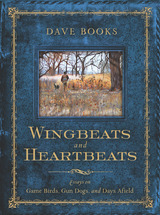 Wingbeats and Heartbeats: Essays on Game Birds, Gun Dogs, and Days Afield
Dave Books; Illustrations by Christopher Smith
University of Wisconsin Press, 2013 Wingbeats and Heartbeats is a wingshooter's odyssey to the wild places where, at the end of the day, the companionship of faithful gun dogs and good friends matters more than a bulging game bag. In this sometimes humorous and sometimes poignant collection of essays, Dave Books celebrates a time-honored connection to the land and the hard-earned hunting rewards of an outdoor life. Through these essays, readers tag along on adventures in the forests of Wisconsin and Minnesota, the fields of Iowa and North Dakota, the prairies of eastern Montana and Nebraska, the mountains of western Montana and Idaho, and the deserts of Arizona. Books also writes of the game birds that hunters pursue and admire: grouse, quail, woodcock, doves, chukars, Hungarian partridge, and waterfowl. A heartfelt tribute to the freedom and magic of the hunt, Wingbeats and Heartbeats is a book that has much to say about work and fun, success and failure, and the sights, sounds, and smells of a day afield.
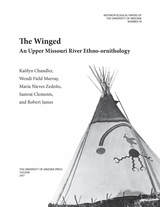 The Winged: An Upper Missouri River Ethno-ornithology
Kaitlyn Chandler, Wendi Field Murray, María Nieves Zedeño, Samrat Clements, and Robert James
University of Arizona Press, 2017 The Missouri River Basin is home to thousands of bird species that migrate across the Great Plains of North America each year, marking the seasonal cycle and filling the air with their song. In time immemorial, Native inhabitants of this vast region established alliances with birds that helped them to connect with the gods, to learn the workings of nature, and to live well. This book integrates published and archival sources covering archaeology, ethnohistory, historical ethnography, folklore, and interviews with elders from the Blackfoot, Assiniboine, Mandan, Hidatsa, Arikara, and Crow communities to explore how relationships between people and birds are situated in contemporary practice, and what has fostered its cultural persistence. Native principles of ecological and cosmological knowledge are brought into focus to highlight specific beliefs, practices, and concerns associated with individual bird species, bird parts, bird objects, the natural and cultural landscapes that birds and people cohabit, and the future of this ancient alliance. Detailed descriptions critical to ethnohistorians and ethnobiologists are accompanied by thirty-four color images. A unique contribution, The Winged expands our understanding of sets of interrelated dependencies or entanglements between bird and human agents, and it steps beyond traditional scientific and anthropological distinctions between humans and animals to reveal the intricate and eminently social character of these interactions.
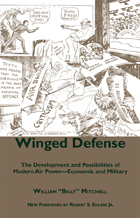 Winged Defense: The Development and Possibilities of Modern Air Power--Economic and Military
William "Billy" Mitchell, with a new foreword by Robert S. Ehlers Jr.
University of Alabama Press, 2009 This book is the basis for airpower doctrine in the US, and demonstrates how forward looking Gen Mitchell was even though the technology for conducting air operations was in its infancy when it was written. It is essential reading for anyone concerned with airpower history or aerospace doctrine. William Lendrum "Billy" Mitchell (December 28, 1879 – February 19, 1936) was an American Army general who is regarded as the father of the U.S. Air Force, and is one of the most famous and most controversial figures in the history of American airpower. Mitchell served in France during the First World War and, by the conflict's end, commanded all American air combat units in that country. After the war, he was appointed deputy director of the Air Service and began to advocate increased investment in air power, claiming this would prove vital in future wars. He particularly stressed the ability of bombers to sink battleships and organized a series of dramatic bombing runs against stationary ships designed to test the idea that attracted wide notice from the public. He antagonized many in both the Army and Navy with his arguments and criticism and, in 1925, was demoted to Colonel. Later that year, he was court-martialed for insubordination after accusing military chiefs of an "almost treasonable administration of the national defense." He resigned from the service shortly thereafter. Mitchell received many honors following his death, including a commission by the President as a Major General. He is also the only individual after whom a type of American military aircraft is named: the B-25 "Mitchell."
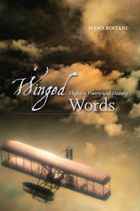 Winged Words: Flight in Poetry and History
Piero Boitani
University of Chicago Press, 2007
Flight has always fascinated human minds, but until a century ago it remained a dream—the exclusive domain of birds, gods, and mythological heroes. From the myths of the ancients to the poetry of Pindar and Yeats, Winged Words traces the imprint of the human impulse to fly from premodern times to the age of terrorism in both literature and history.
Piero Boitani begins his analysis with an account of the way the myths of Pegasus and Icarus have persisted from classical to twentieth-century politics and literature. He then takes up the figure of Hermes; the roles of halcyons and eagles in classical, biblical, and later literatures; and literary response to Pieter Brueghel’s The Fall of Icarus. Honing in on modern figures and concerns, Boitani also offers a fascinating discussion of author-pilot Antoine de Saint-Exupéry and concludes with a meditation on the flight of the hijacked airliners on 9/11. Throughout, Winged Word brings a remarkable range of men of action, politicians, theologians, writers, and artists into dialogue with each other: Shakespeare with T. S. Eliot, Horace with Ovid, Leonardo with Milton, Leopardi with Mallarmé, Saint-Exupéry with Faulkner and Rilke, and the Ulysses of Homer with the Ulysses of Dante. Ultimately, by showing how writers and fliers have looked to the ancients for inspiration, Boitani testifies to the modern relevance of poetry and the classics.
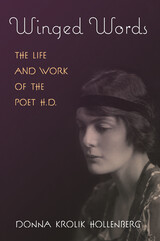 Winged Words: The Life and Work of the Poet H.D.
Donna Krolik Hollenberg
University of Michigan Press, 2022 Winged Words puts the work of H.D., including her poetry, translations, and prose, in the context of her life. Because the majority of H.D.’s oeuvre was unpublished until recently, author Donna Hollenberg, who’s written three previous books about H.D., is able to account for and analyze significantly more of H.D.’s work than previous biographers.
H.D.’s friends and lovers were a veritable Who’s Who of Modernism, and Hollenberg gives us a glimpse into H.D.’s relationships with them. With rich detail, the biography follows H.D. from her early years in America with her family, to her later years in England during both world wars, to Switzerland, which would eventually become H.D.’s home base. It explores her love affairs with both men and women; her long friendship with Bryher; the birth of her daughter, Perdita, and her imaginative bond with her; and her marriage to (and later divorce from) fellow poet Richard Aldington. Additionally, the book includes scenes from her relationships with Ezra Pound, Marianne Moore, William Carlos Williams, and D.H. Lawrence; H.D.’s fascination with spiritualism and the occult; and H.D.’s psychoanalysis with Sigmund Freud. The first new biography of H.D. to be published in over four decades, Winged Words is a must-read resource for anyone conducting research on H.D.
Wingless Flights: Appalachian Women in Fiction
Danny L. Miller
University of Wisconsin Press, 1996 In this innovative work, Danny L. Miller surveys some of the depictions of mountain women from the 1880s to the 1950s, in the writings of Mary Noailles Murfree, Edith Summers Kelley, Anne W. Armstrong, Emma Bell Miles, Jesse Stuart, James Still, and Harriette Arnow. The major aims of the study are to show changes in the descriptions of mountain women—from non-native to native portrayals; from romantic to realistic presentations; and from an emphasis on victimization and drudgery to an emphasis on strength and endurance. Miller identifies qualities that have consistently characterized mountain women in literature.
 Wings for the Rising Sun: A Transnational History of Japanese Aviation
Jürgen P. Melzer
Harvard University Press, 2020 The history of Japanese aviation offers countless stories of heroic achievements and dismal failures, passionate enthusiasm and sheer terror, brilliant ideas and fatally flawed strategies.
In Wings for the Rising Sun, scholar and former airline pilot Jürgen Melzer connects the intense drama of flight with a global history of international cooperation, competition, and conflict. He details how Japanese strategists, diplomats, and industrialists skillfully exploited a series of major geopolitical changes to expand Japanese airpower and develop a domestic aviation industry. At the same time, the military and media orchestrated air shows, transcontinental goodwill flights, and press campaigns to stir popular interest in the national aviation project. Melzer analyzes the French, British, German, and American influence on Japan’s aviation, revealing in unprecedented detail how Japanese aeronautical experts absorbed foreign technologies at breathtaking speed. Yet they also designed and built boldly original flying machines that, in many respects, surpassed those of their mentors.
Wings for the Rising Sun compellingly links Japan’s aeronautical advancement with public mobilization, international relations, and the transnational flow of people and ideas, offering a fresh perspective on modern Japanese history.
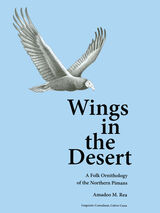 Wings in the Desert: A Folk Ornithology of the Northern Pimans
Amadeo M. Rea
University of Arizona Press, 2008 There is a common but often unspoken arrogance on the part of outside observers that folk science and traditional knowledge—the type developed by Native communities and tribal groups—is inferior to the “formal science” practiced by Westerners. In this lucidly written and humanistic account of the O’odham tribes of Arizona and Northwest Mexico, ethnobiologist Amadeo M. Rea exposes the limitations of this assumption by exploring the rich ornithology that these tribes have generated about the birds that are native to their region. He shows how these peoples’ observational knowledge provides insights into the behaviors, mating habits, migratory patterns, and distribution of local bird species, and he uncovers the various ways that this knowledge is incorporated into the communities’ traditions and esoteric belief systems. Drawing on more than four decades of field and textual research along with hundreds of interviews with tribe members, Rea identifies how birds are incorporated, both symbolically and practically, into Piman legends, songs, art, religion, and ceremonies. Through highly detailed descriptions and accounts loaded with Native voice, this book is the definitive study of folk ornithology. It also provides valuable data for scholars of linguistics and North American Native studies, and it makes a significant contribution to our understanding of how humans make sense of their world. It will be of interest to historians of science, anthropologists, and scholars of indigenous cultures and folk taxonomy.
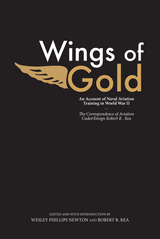 Wings of Gold: An Account of Naval Aviation Training in World War II, The Correspondence of Aviation Cadet/Ensign Robert R. Rea
Wesley Phillips Newton
University of Alabama Press, 1987 Wings of Gold makes a unique contribution to the history of naval aviation. The book sets out the day-to-day experiences and reactions of a cadet who went through the aviation training program at its peak during World War II. An emphasis on training is missing in almost all books dealing with that conflict; in this book, it is the focus. In contrast with official histories, this is an account of how training did occur, rather than how it was intended to occur. It chronicles failures as well as successes, frustrations and achievements. Beginning with a comprehensive introduction to the history of naval aviation training, the authors recount the personal experiences of an individual cadet preparing for war, based on wartime letters written by cadet Rea to his family. The letters are open and candid, and they provide an insider’s look at the conditions and nature of the Naval Aviation Training Program in the 1940s.
Millions of Americans underwent military training during World War II, and contemporary historians and readers have begun to recognize the significance and value of primary sources related not only to combat but also to training and preparedness.
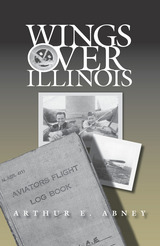 Wings Over Illinois
Arthur E. Abney
Southern Illinois University Press, 2007 Wings over Illinois recounts World War II veteran Arthur Abney’s illustrious aviation career, effectively documenting a span in our own nation’s history from the vantage of the skies. Abney describes a lifetime of experience, from his time as an eager young pilot with the Flying Egyptians to his tour of service during World War II, his years with the Illinois Department of Aeronautics, American Airlines, and the Southern Illinois University Aviation Management and Flight program.
Abney introduces readers to hangar flying—exciting end-of-day flight tales told in the hangar—with sixty stories provided by military and civilian airmen from across the country. Included are such accounts as a 1943 bombing squadron assignment over Saipan in a typhoon, an engine freeze on takeoff during a solo training flight, a white-knuckle Bermuda Triangle flight, and a power failure on a homebuilt aircraft. Complementing Abney’s own experiences, these stories offer insights into the split-second decision making necessary to resolve problems in the air.
In this fascinating autobiography Abney takes readers on a journey through nearly seven decades of a life in aviation.
 Wings over the Mexican Border: Pioneer Military Aviation in the Big Bend
By Kenneth Baxter Ragsdale
University of Texas Press, 1997 Against a backdrop of revolution, border banditry, freewheeling aerial dramatics, and World War II comes this compelling look at the rise of U.S. combat aviation at an unlikely proving ground—a remote airfield in the rugged reaches of the southwestern Texas borderlands. Here, at Elmo Johnson's Big Bend ranch, hundreds of young Army Air Corps pilots demonstrated the U.S. military's reconnaissance and emergency response capabilities and, in so doing, dramatized the changing role of the airplane as an instrument of war and peace. Kenneth Ragsdale's gripping account not only sets the United States squarely in the forefront of aerial development but also provides a reflective look at U.S.-Mexican relations of the 1920s, 1930s, and 1940s, particularly the tense days and aftermath of the Escobar Rebellion of 1929. He paints a vivid picture of the development of the U.S. aerial strike force; the character, ideals, and expectations of the men who would one day become combat leaders; and the high esteem in which U.S. citizens held the courageous pilots. Particularly noteworthy is Ragsdale's portrait of Elmo Johnson, the Big Bend rancher, trader, and rural sage who emerges as the dominant figure at one of the most unusual facilities in the annals of the Air Corps. Wings over the Mexican Border tells a stirring story of the American frontier juxtaposed with the new age of aerial technology.
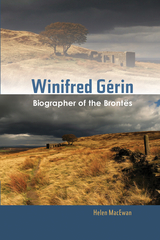 Winifred Gerin: Biographer of the Brontes
Helen Macewan
Sussex Academic Press, 2022 The biographer Winifred Grin (190181), who wrote the lives of all four Bront siblings, stumbled on her literary vocation on a visit to Haworth, after a difficult decade following the death of her first husband. On the same visit she met her second husband, a Bront enthusiast twenty years her junior. Together they turned their backs on London to live within sight of the Parsonage, Grin believing that full understanding of the Bronts required total immersion in their environment. Grin's childhood and youth, like the Bronts', was characterised by a cultured home and an intense imaginative life shared with her sister and two brothers, and by family tragedies (the loss of two siblings in early life). Strong cultural influences formed the children's imagination: polyglot parents, French history, the Crystal Palace, Old Vic productions. Winifred's years at Newnham College, Cambridge were enlivened by such eccentric characters as the legendary lecturer Arthur Quiller-Couch ('Q'), Lytton Strachey's sister Pernel, and Bloomsbury's favourite philosopher, G.E. Moore. Her happy life in Paris with her Belgian cellist husband, Eugne Grin, was brought to an abrupt end by the Second World War, during which the couple had many adventures: fleeing occupied Belgium, saving Jews in Vichy France, and escaping through Spain and Portugal to England, where they did secret war work for the Political Intelligence Department near Bletchley Park. After Eugne's death in 1945 Winifred coped with bereavement by writing poetry and plays until discovering her true literary metier on her visit to Haworth. She also wrote about Elizabeth Gaskell, Anne Thackeray Ritchie and Fanny Burney. This book is based on her letters and on her unpublished memoir.
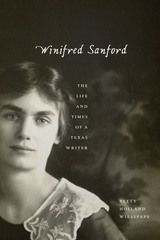 Winifred Sanford: The Life and Times of a Texas Writer
Betty Holland Wiesepape
University of Texas Press, 2013 Winifred Sanford is generally regarded by critics as one of the best and most important early twentieth-century Texas women writers, despite publishing only a handful of short stories before slipping into relative obscurity. First championed by her mentor, H. L. Mencken, and published in his magazine, The American Mercury, many of Sanford’s stories were set during the Texas oil boom of the 1920s and 1930s and offer a unique perspective on life in the boomtowns during that period. Four of her stories were included in The Best American Short Stories of 1926. Questioning the sudden end to Sanford’s writing career, Wiesepape, a leading literary historian of Texas women writers, delved into the author’s previously unexamined private papers and emerged with an insightful and revealing study that sheds light on both Sanford’s abbreviated career and the domestic lives of women at the time. The first in-depth account of Sanford’s life and work, Wiesepape’s biography discusses Sanford’s fiction through the lens of the sociohistorical contexts that shaped and inspired it. In addition, Wiesepape has included two previously unpublished stories as well as eighteen previously unpublished letters to Sanford from Mencken. Winifred Sanford is an illuminating biography of one of the state’s unsung literary jewels and an important and much-needed addition to the often overlooked field of Texas women’s writing.
 Winks and Daggers: An Inside Look at Another Year in Boxing
Thomas Hauser
University of Arkansas Press, 2011 Thomas Hauser's annual collections have been avidly anticipated from the time A Beautiful Sickness was published by the University of Arkansas Press in 2001 until his most recent collection, Boxing Is . . . , was named a 2010 Best Sports Book of the Year by Booklist, which has called Hauser "the current champ in boxing literature." Sportswriter Donald McRae recently wrote, "Thomas Hauser has become boxing's indispensable writer with a stream of books and internet columns that strip away the layers of intrigue to reveal a seamy but addictive world. Whether writing Muhammad Ali's biography, or shredding boxing's power brokers, Hauser instills passion and gravitas into his work." Winks and Daggers continues that tradition with Hauser's writing from 2010. Hauser brings readers into Manny Pacquiao's intimate circle in the moments before last year's two biggest fights. His award-winning investigative journalism exposes the inner workings of HBO Sports and examines the use of performance-enhancing drugs in boxing. There's a look back in time at Rocky Marciano and Sugar Ray Leonard. And there's much more in this latest collection in the series that has become, according to reviewer Bart Barry, "an essential part of boxing's official record and the chronicles of this era most likely to endure."
Winnebago Mysteries and Other Stories
Moira Crone
University of Alabama Press, 1982 Fresh writings about women, love, and strength
In this collection of seven short stories, Moira Crone presents fresh writings about women, love, and strength. "Kudzu" is a tale of a girl's childhood in the stranglehold of American life. "The Brooklyn Lie" deals with a young woman's sexuality and body. The title story explores relationships and women's issues through a series of letters and narratives.
Winners and Losers: Social and Political Polarities in America
Irving Louis Horowitz
Duke University Press, 1984 Leading sociologist Irving Louis Horowitz examines the response social science has made to contemporary subjects and issues: the so-called "new class" of the intelligentsia, the ecology movement, social planning, alienation, privatization, anomie, the threat of nuclear war. Horowitz evaluates as a social scientist the question of values—those disclosed through analysis, and those threatened by it—and discusses the overall political and moral impact of knowledge and methodology in social science.
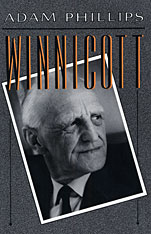 Winnicott
Adam Phillips
Harvard University Press, 1988 Although he founded no school of his own, D. W. Winnicott (1896–1971) is now regarded as one of the most influential contributors to psychoanalysis since Freud. In over forty years of clinical practice, he brought unprecedented skill and intuition to the psychoanalysis of children. This critical new work by Adam Phillips presents the best short introduction to the thought and practice of Winnicott that is currently available.
Winnicott’s work was devoted to the recognition and description of the good mother and the use of the mother–infant relationship as the model of psychoanalytic treatment. His belief in natural development became a covert critique of overinterpretative methods of psychoanalysis. He combined his idiosyncratic approach to psychoanalysis with a willingness to make his work available to nonspecialist audiences. In this book Winnicott takes his place with Melanie Klein and Jacques Lacan as one of the great innovators within the psychoanalytic tradition.
 Winning Grants
Stephanie K. Gerding
American Library Association, 2016 Newly revised and refreshed, this invaluable how-to manual will teach you the skills and strategies crucial for finding, applying for, and winning grants. Whether you're starting from scratch and don't know where to begin, or you're an experienced grant writer looking to tap into new funding sources, this resource offers a proven, easy-to-understand process for grant success. Loaded with a wide variety of forms, worksheets, and checklists to help you stay organized, this book: - summarizes the grant process cycle and outlines a clear path to success;
- shares inspiring grant success stories in action from diverse libraries;
- offers guidance on gathering knowledge and conducting research, with updated resource lists and links to the various types of funders;
- covers every stage of planning, including how to cultivate community involvement, methods for needs assessment, advice on organizing the grant team, and exercises to help you write realistic goals and objectives;
- gives tips on writing the proposal, such as where to find the best statistics and census data to support your statement of needs;
- advises how to announce a successful grant to the community, and other first steps of implementation, including the basic principles of project management;
- provides guidance on what to do when you're turned down and how to conduct an effective review session that keeps the process moving forward;
- highlights ways to stay current through online discussion groups, blogs, networking groups, and more; and
- features sample RFPs, budget templates, grant partnership documents, and many other helpful tools.
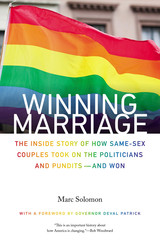 Winning Marriage: The Inside Story of How Same-Sex Couples Took on the Politicians and Pundits—and Won
Marc Solomon
University Press of New England, 2014 Ten years ago no state allowed same-sex couples to marry, support for gay marriage nationwide hovered around 30 percent, and politicians everywhere thought of it as the third rail of American politics—draw near at your peril. Today, same-sex couples can marry in seventeen states, polls consistently show majority support, and nearly three-quarters of Americans believe legalization is inevitable. In Winning Marriage Marc Solomon, a veteran leader in the movement for marriage equality, gives the reader a seat at the strategy-setting and decision-making table in the campaign to win and protect the freedom to marry. With depth and grace he reveals the inner workings of the advocacy movement that has championed and protected advances won in legislative, court, and electoral battles over the decade since the landmark Massachusetts ruling guaranteeing marriage for same-sex couples for the first time. From the gritty battles in the state legislatures of Massachusetts and New York to the devastating loss at the ballot box in California in 2008 and subsequent ballot wins in 2012 to the joyous victories of securing President Obama’s support and prevailing in the Supreme Court, Marc Solomon has been at the center of one of the great civil and human rights movements of our time. Winning Marriage recounts the struggle with some of the world’s most powerful forces—the Catholic hierarchy, the religious right, and cynical ultraconservative political operatives—and the movement’s eventual triumph.
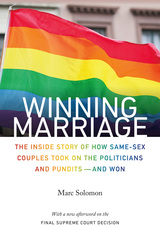 Winning Marriage: The Inside Story of How Same-Sex Couples Took on the Politicians and Pundits—and Won
Marc Solomon
University Press of New England, 2015 In this updated, paperback edition of Winning Marriage, Marc Solomon, a veteran leader in the movement for marriage equality, gives the reader a seat at the strategy-setting and decision-making table in the campaign to win and protect the freedom to marry. With depth and grace he reveals the inner workings of the advocacy movement that has championed and protected advances won in legislative, court, and electoral battles over the years since the landmark Massachusetts ruling guaranteeing marriage for same-sex couples for the first time. The paperback edition includes a new afterword on the historic 2015 Supreme Court ruling on marriage that includes practical lessons from the marriage campaign that are applicable to other social movements. From the gritty clashes in the state legislatures of Massachusetts and New York to the devastating loss at the ballot box in California in 2008 and subsequent ballot wins in 2012 to the joys of securing President Obama’s support and achieving ultimate victory in the Supreme Court, Marc Solomon has been at the center of one of the great civil and human rights movements of our time. Winning Marriage recounts the struggle with some of the world’s most powerful forces—the Catholic hierarchy, the religious right, and cynical ultraconservative political operatives—and the movement’s eventual triumph.
Winning Strategies for the Indian Market
Anuradha Dayal-Gulati
Northwestern University Press, 2010 The essays in this collection focus primarily on six major business sectors in India: airlines, pharmaceuticals, automobiles, hospitality, food, and telecommunications. An essay on each sector describes the market structure, the current state of the sector, the main players, the key economic forces, and selected business strategies.
The authors describe how the sector might evolve during the next five to ten years, within the broad canvas of the deeper economic and demographic transitions that are taking place in India, and in turn, what this evolution implies for the challenges and opportunities that companies, both domestic and multinational, may face in India. Essays on the emergence of the Indian consumer, the effect of credit cards on India’s consumer culture, and entrepreneurship and India’s poor the emergence of the Indian Consumer round out this profile of India’s market.
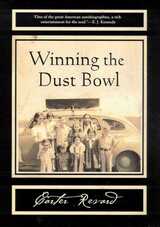 Winning the Dust Bowl
Carter Revard
University of Arizona Press, 2001 Bootleggers and bankrobbers in the Oklahoma Dust Bowl. Proctors and punters at Oxford. Activists and agitators of the American Indian Movement. Carter Revard has known them all, and in this book— a memoir in prose and poetry— he interweaves the many threads of his life as only a gifted writer can. Winning the Dust Bowl traces Revard's development from a poor Oklahoma farm boy during the depths of the Depression to a respected medieval scholar and outstanding Native American poet. It recounts his search for a personal and poetic voice, his struggle to keep and expand it, and his attempt to find ways of reconciling the disparate influences of his life. In these pages, readers will find poems both new and familiar: poems of family and home, of loss and survival. In linking— what he calls "cocooning"— essays, Revard shares what he has noticed about how poems come into being, how changes in style arise from changes in life, and how language can be used to deal with one's relationship to the world. He also includes stories of Poncas and Osages, powwow stories and Oxford fables, and a gallery of photographs that capture images of his past. Revard has crafted a book about poetry and authorship, about American history and culture. Lyrical in one breath and stingingly political in the next, he calls on his mastery of language to show us the undying connection between literature and life.
Winning the Game and Other Stories
Rubem Fonseca
Tagus Press, 2013 In these seventeen stories by one of Brazil's foremost living authors, Fonseca introduces readers—with unsurpassed candor and keenness of observation—to a kaleidoscopic, often disturbing world. A hunchback sets his lascivious sights on seducing a beautiful woman. A wealthy businessman hires a ghost writer, with unexpected results. A family of modern-day urban cannibals celebrates a bizarre rite of passage. A man roams the nocturnal streets of Rio de Janeiro in search of meaning. A male ex-police reporter writes an advice column under a female pseudonym. A prosperous entrepreneur picks up a beautiful girl in his Mercedes only to discover his costly mistake. A loser elaborates a lethal plan to become, in his mind, a winner.
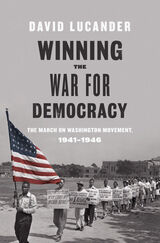 Winning the War for Democracy: The March on Washington Movement, 1941-1946
David Lucander
University of Illinois Press, 2014 Scholars regard the March on Washington Movement (MOWM) as a forerunner of the postwar Civil Rights movement. Led by the charismatic A. Philip Randolph, MOWM scored an early victory when it forced the Roosevelt administration to issue a landmark executive order that prohibited defense contractors from practicing racial discrimination. Winning the War for Democracy: The March on Washington Movement, 1941-1946 recalls that triumph, but also looks beyond Randolph and the MOWM's national leadership to focus on the organization's evolution and actions at the local level. Using the personal papers of previously unheralded MOWM members such as T.D. McNeal, internal government documents from the Roosevelt administration, and other primary sources, David Lucander highlights how local affiliates fighting for a double victory against fascism and racism helped the national MOWM accrue the political capital it needed to effect change. Lucander details the efforts of grassroots organizers to implement MOWM's program of empowering African Americans via meetings and marches at defense plants and government buildings and, in particular, focuses on the contributions of women activists like Layle Lane, E. Pauline Myers, and Anna Arnold Hedgeman. Throughout he shows how local activities often diverged from policies laid out at MOWM's national office, and how grassroots participants on both sides ignored the rivalry between Randolph and the leadership of the NAACP to align with one another on the ground.
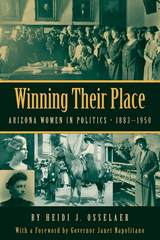 Winning Their Place: Arizona Women in Politics, 1883-1950
Heidi J. Osselaer
University of Arizona Press, 2009 In January 1999, five women were elected to the highest offices in Arizona, including governor, secretary of state, attorney general, treasurer, and superintendent of public instruction. The “Fab Five,” as they were dubbed by the media, were sworn in by U.S. Supreme Court Justice Sandra Day O’Connor, herself a former member of the Arizona legislature. Some observers assumed that the success of women in Arizona politics was a result of the modern women’s movement, but Winning Their Place convincingly demonstrates that these recent political victories have a long and fascinating history.
This landmark book chronicles for the first time the participation of Arizona women in the state’s early politics. Incorporating impressive original research, Winning Their Place traces the roots of the political participation of women from the territorial period to after World War II. Although women in Arizona first entered politics for traditional reasons—to reform society and protect women and children—they quickly realized that male politicians were uninterested in their demands. Most suffrage activists were working professional women, who understood that the work place discriminated against them. In Arizona they won the vote because they demanded rights as working women and aligned with labor unions and third parties that sympathized with their cause. After winning the vote, the victorious suffragists ran for office because they believed men could not and would not represent their interests.
Through this process, these Arizona women became excellent politicians. Unlike women in many other states, women in Arizona quickly carved out a place for themselves in local and state politics, even without the support of the reigning Democratic Party, and challenged men for county office, the state legislature, state office, Congress, and even for governor. This fascinating book reveals how they shattered traditional notions about “a woman’s place” and paved the way for future female politicians, including the “Fab Five” and countless others who have changed the course of Arizona history.
 The Winnington Letters: John Ruskin’s Correspondence with Margaret Alexis Bell and the Children at Winnington Hall
John Ruskin and Margaret Alexis Bell; edited by Van Akin Burd
Harvard University Press This series of letters written between 1859 and 1868 by John Ruskin to Miss Bell and the girls of her school in Cheshire and discovered in a Brighton house in 1952 reveal for the first time the extent of the friendship between Miss Bell and Ruskin. She was a sympathetic listener, with whom he could discuss the spiritual crisis that marked his life during his important middle years, when he was completing Modern Painters and his earlier books on political economy. Van Akin Burd studies the letters as an expression of this struggle. He also develops a portrait of the unorthodox schoolmistress, and suggests her reasons for turning to the art critic.
Besides the charming pictures of Ruskin with the children, the correspondence provides new sources for his ideas on art, education, and religion, as well as additional insight into his tragic love for Rose La Touche. Most of Ruskin's letters to Winnington have been collected by the Pierpont Morgan Library. Of the 542 letters in this volume, 497 have not been published before.
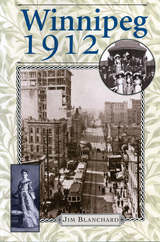 Winnipeg 1912
Jim Blanchard
University of Manitoba Press, 2005 At the beginning of the last century, no city on the continent was growing faster or was more aggressive than Winnipeg. No year in the city’s history epitomized this energy more that 1912, when Winnipeg was on the crest of a period of unprecedented prosperity. In just forty years, it had grown from a village on the banks of the Red River to become the third largest city in Canada. In the previous decade alone, its population had tripled to nearly 170,000 and it now dominated the economy and society of western Canada. As Canada’s most cosmopolitan and ethnically diverse centre, with most of its population under the age of forty, it was also the country’s liveliest city, full of bustle and optimism. In Winnipeg 1912 Jim Blanchard guides readers on a tour through this golden year when, as the Chicago Tribune proclaimed, “all roads lead to Winnipeg.” Beginning early New Year’s Day, as the city’s high society rang in 1912 at the Royal Alexandra Hotel, he visits the public and private side of the “Chicago of the North.” He looks into the opulent mansions of the city’s new elite and into its political backrooms, as well as into the crowded homes of Winnipeg’s immigrant North End. From the excited crowds at the summer Exhibition to the turbulent floor of the Grain Exchange, Blanchard gives us a vivid picture of daily life in this fast-paced city of new millionaires and newly arrived immigrants. Richly illustrated with more than seventy period photographs, Winnipeg 1912 captures a time and place that left a lasting impression on Canadian history and culture.
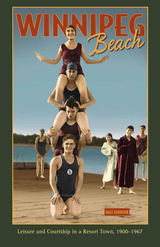 Winnipeg Beach: Leisure and Courtship in a Resort Town, 1900-1967
Dale Barbour
University of Manitoba Press, 2011 During the first half of the twentieth century, Winnipeg Beach proudly marketed itself as the Coney Island of the West. Located just north of Manitoba's bustling capital, it drew 40,000 visitors a day and served as an important intersection between classes, ethnic communities, and perhaps most importantly, between genders. In Winnipeg Beach, Dale Barbour takes us into the heart of this turn-of-the-century resort area and introduces us to some of the people who worked, played and lived in the resort. Through photographs, interviews, and newspaper clippings he presents a lively history of this resort area and its surprising role in the evolution of local courtship and dating practices, from the commoditization of the courting experience by the Canadian Pacific Railway's "Moonlight Specials," through the development of an elaborate amusement area that encouraged public dating, and to its eventual demise amid the moral panic over sexual behaviour during the 1950s and '60s.
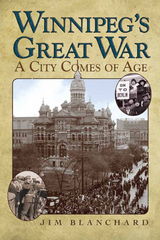 Winnipeg's Great War: A City Comes of Age
Jim Blanchard
University of Manitoba Press, 2010 From the local bestselling author of Winnipeg 1912 comes the riveting next chapter in the city’s history. Winnipeg’s Great War picks up in 1914, just as the city is regrouping after a brief economic downturn. War comes unexpectedly, thoughts of recovery are abandoned, and the city digs in for a hard-fought four years.Using letters, diaries, and newspaper reports, Jim Blanchard brings us into the homes and public offices of Winnipeg and its citizens to illustrate the profound effect the war had on every aspect of the city, from its politics and economy, to its men on the battlefield, and its war-weary families fighting on the home front. We witness the emergence of the city’s social welfare services through the work of women’s volunteer organizations; the political scandals that led to the fall of the Rodmond Roblin government; and the clash between independent jitneys and the city’s private transit company. And we hear the conflicted emotions that echoed in the city’s streets, from anti-foreign sentiment and labour unrest, to patriotic parades, and a spontaneous Victory Day celebration that refused to end.Through these stories, Blanchard reveals how these crucial years set the stage for the decades ahead, and how the First World War transformed Winnipeg into the city it is today.
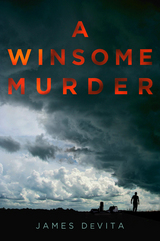 A Winsome Murder
James DeVita
University of Wisconsin Press, 2015 A grisly murder in a pastoral Wisconsin town, Winsome Bay, proves to be only the opening act in a twisting, darkening series of gruesome deaths. Acclaimed already for his young adult fiction, actor/director/playwright James DeVita now debuts an addictive, adult thriller that takes us from Chicago’s underbelly to the Wisconsin woods.
In this fast-paced novel we meet a gorgeous waitress with a haunted past, an author juggling a failing career and motherhood, and a hard-bitten detective with unexpected inspiration from William Shakespeare’s bloodiest plays—and nobody escapes the nightmare created by a psychotic killer of women.
Best books for public & secondary school libraries from university presses, American Library Association
Outstanding Achievement Award, Wisconsin Library Association (one of ten 2015 books chosen)
“A page-turner from beginning to end. . . . Certain to be an enduringly popular addition to community library Mystery/Suspense collections.”—Midwest Book Review
“In addition to a unique detective, a wholly original story, and some literary flair, DeVita has filled these pages with timely and biting social commentary, which does much to add to the real feel of this creative whodunit.”—Chicago Book Review
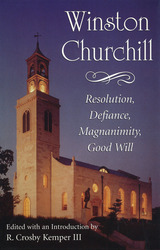 Winston Churchill: Resolution, Defiance, Magnanimity, Good Will
Edited by R. Crosby Kemper III
University of Missouri Press, 1995 In 1946 Winston Churchill shook the world with his famous "Iron Curtain" speech on the campus of Westminster College in Fulton, Missouri, now the site of the Winston Churchill Memorial and Library. Inscribed on the pediment of his statue at the memorial is the epigraph from Churchill's History of the Second World War: In War: Resolution In Defeat: DefianceIn Victory: MagnanimityIn Peace: Good Will No other words provide so poignant a summary of the principles that sustained Churchill's life's work. Under the auspices of the Winston Churchill Memorial and Library, the Crosby Kemper Lectureship was established in 1979 by the Enid and Crosby Kemper Foundation of Kansas City, Missouri. Lectures have been delivered annually, or biennially, at the Winston Churchill Memorial and Library on the campus of Westminster College by authorities on British history and on Sir Winston Churchill. The essays included in this volume constitute the first dozen Crosby Kemper lectures, most by individuals who were personally acquainted with Churchill and all by individuals who had studied his life and his work. Lord Robert Blake discusses Churchill's ambivalence toward the Conservative party during his political career. Philip S. Ziegler, Earl Mountbatten's biographer, examines whether Britain should have granted independence to India in 1947, taking as his departure Churchill's unequivocal belief that Britain's imperial rule there was a sacred trust not to be betrayed. Martin Gilbert, Churchill's biographer, carefully examines the origins of the Cold War and the famous Iron Curtain speech. Sir Michael Howard, Lovett Professor and Naval Historian at Yale University, further examines Churchill's role during the Cold War and the formulation of his "two-track" strategy that pushed for military strength while persistently striving for peace with the Soviets. Sir John Colville, Churchill's private secretary, ponders the extent to which great men are made by circumstances, citing Churchill's peccadilloes and strengths. Churchill's daughter Mary Soames and granddaughter, the sculptor Edwina Sandys, also give moving portraits of a much-loved family man. All bring this illustrious leader to life in the process of interpreting his political actions, reviewing his historical contributions, and sharing anecdotes about his personal life.
Winter Amnesties
Elton Glaser
Southern Illinois University Press, 2000 Winter Amnesties is a book of origins and endings, griefs and reconciliations. Each poem addresses the dilemma posed by G. K. Chesterton: “One must somehow find a way of loving the world without trusting it.” The poems revisit the past, assess the present, and stare hard into the future. At middle age, Glaser remembers his youth in Louisiana and settles into the long stretch of his adult years in Ohio; he makes his peace with “the life that allows.” As son, as father, as poet, he looks to his legacy, whatever dim remnant of himself might continue after “all flesh falls back to salt and cinder.” But these are poems of brio and bitter wit, not of self-pity and surrender. They take a jaunty stance towards life and welcome whatever the days may bring, confident that, like crows in the harvest cornfield, we can live on “the shocks and waste of this world” and “wring gold grain from the ruin.”
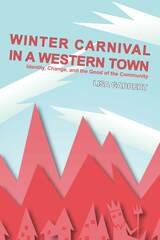 Winter Carnival in a Western Town: Identity, Change and the Good of the Community
Lisa Gabbert
Utah State University Press, 2011 Held annually, the McCall, Idaho, winter carnival has become a modern tradition. A festival and celebration, it is also a source of community income and opportunity for shared community effort; a chance to display the town attractively to outsiders and to define and assert McCall's identity; and consequently, a source of disagreement among citizens over what their community is, how it should be presented, and what the carnival means.
Though rooted in the broad traditions of community festival, annual civic events, often sponsored by chambers of commerce, such as that in McCall, are as much expressions of popular culture and local commerce as of older traditions. Yet they become dynamic, newer community traditions, with artistic, informal, and social meanings and practices that make them forms of folklore as well as commoditized culture. Winter Carnival is the first volume in a new Utah State University Press series titled Ritual, Festival, and Celebration and edited by folklorist Jack Santino.
Winter Dialogue
Tomas Venclova
Northwestern University Press, 1999 Best known in the U.S. as a scholar and critic, Tomas Venclova is a gifted poet whose work has remained largely unknown to an English-speaking audience. This collection of fifty-one poems is as distinctive as it is finely crafted. Also included is a foreword by Joseph Brodsky and an exchange between Venclova and Czeslaw Milosz.
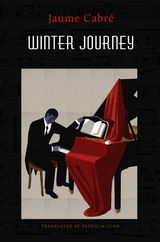 Winter Journey
Jaume Cabré
Swan Isle Press, 2009 With this highly original collection of short stories, Catalonian writer Jaume Cabré takes his place among the masters of the form. In Winter Journey, the reader encounters disparate and often desperate characters—pianist, cuckold, whore, organ builder, rabbi, priest, scholar, thief, hitman, madman, Holocaust survivor, oligarch, failed artist—who challenge notions about will, morality, and “the riddle of existence.” This is not a selection of individual stories, but a singularly brilliant and enigmatic narrative, novelistic in its approach, with mysterious connections linking characters, objects, and ideas across time and place. The text takes the form of a Schubertian musical progression in prose, a philosophical mystery moving freely through a labyrinth of centuries and cities, historical and contemporary.
Richly allusive with its themes and motifs of music and art, Winter Journey will continue to provoke questions long after the reader has closed the book. This edition represents the first translation of Cabré’s work into English and an invitation to many more readers to come along for the ride.
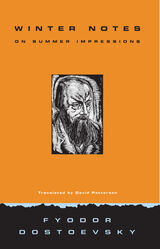 Winter Notes on Summer Impressions
Fyodor Dostoevsky
Northwestern University Press, 1997 Winter Notes on Summer Impressions (Зимние заметки о летних впечатлениях) is an early book-length essay by Russian author Fyodor Dostoevsky which he composed while traveling in western Europe. Many commentators believe that in the themes it explores, the essay anticipates his later work Notes from the Underground.
In June 1862, Dostoevsky left Petersburg on his first excursion to Western Europe. Ostensibly making the trip to consult Western specialists about his epilepsy, he also wished to see firsthand the source of the Western ideas he believed were corrupting Russia. Over the course of his journey he visited a number of major cities, including Berlin, Paris, London, Florence, Milan, and Vienna. He recorded his impressions in Winter Notes on Summer Impressions, which were first published in the February 1863 issue of Vremya (Time), the periodical of which he was the editor.
Among other themes, Dostoevsky reveals his Pan-Slavism, rejecting European culture as corrupt and exhorting Russians to resist the temptation to emulate or adopt European ways of life.
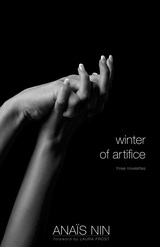 Winter of Artifice: Three Novelettes
Anaïs Nin
Ohio University Press, 2016 Swallow Press first published Winter of Artifice in 1945, following two vastly different versions from other presses. The book opens with a film star, Stella, studying her own, but alien, image on the screen. It ends in the Manhattan office of a psychoanalyst—the Voice—who, as he counsels patients suffering from the maladies of modern life, reveals himself as equally susceptible to them. The middle, title story explores one of Nin’s most controversial themes, that of a woman’s sexual relationship with her father. Elliptical, fragmented prose; unconventional structure; surrealistic psychic landscapes—Nin forged these elements into a style that engaged with the artistic concerns of her time but still registers as strikingly contemporary. This reissue, accompanied by a new introduction by Laura Frost and the original engravings by Nin’s husband Ian Hugo, presents an important opportunity to consider anew the work of an author who laid the groundwork for later writers. Swallow Press’s Winter of Artifice represents a literary artist coming into her own, with the formal experimentation, thematic daring, and psychological intrigue that became her hallmarks.
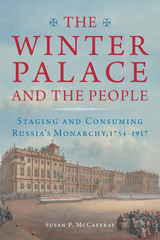 The Winter Palace and the People: Staging and Consuming Russia's Monarchy, 1754–1917
Susan P. McCaffray
Northern Illinois University Press, 2018 St. Petersburg’s Winter Palace was once the supreme architectural symbol of Russia’s autocratic government. Over the course of the nineteenth and early twentieth centuries, it became the architectural symbol of St. Petersburg itself. The story of the palace illuminates the changing relationship between monarchs and their capital city during the last century and a half of Russian monarchy. In The Winter Palace and the People, Susan McCaffray examines interactions among those who helped to stage the ceremonial drama of monarchy, those who consumed the spectacle, and the monarchs themselves.
In the face of a changing social landscape in their rapidly growing nineteenth-century capital, Russian monarchs reoriented their display of imperial and national representation away from courtiers and toward the urban public. When attacked at mid-century, monarchs retreated from the palace. As they receded, the public claimed the square and the artistic treasures in the Imperial Hermitage before claiming the palace itself. By 1917, the Winter Palace had come to be the essential stage for representing not just monarchy, but the civic life of the empire-nation. What was cataclysmic for the monarchy presented to those who staffed the palace and Hermitage not a disaster, but a new mission, as a public space created jointly by monarch and city passed from the one to the other. This insightful study will appeal to scholars of Russia and general readers interested in Russian history.
Winter Quarters
Maurine Ward
Utah State University Press, 2002 Volume 1, Life Writings of Frontier Women series, edited by Maureen Ursenbach Beecher Mary Richard's journals and letters record a young woman's rare, but richly detailed view of life in the temporary Mormon pioneer communities in Iowa.
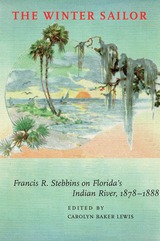 The Winter Sailor: Francis R. Stebbins on Florida's Indian River, 1878-1888
Edited by Carolyn Frances Baker Lewis
University of Alabama Press, 2004 A unique guide to Florida's frontier history along Indian River. The Winter Sailor is a historical adventure that details the yearly winter travels of Francis R. Stebbins to Florida's Indian River. Stebbins, a writer from Michigan, visited Florida in March of 1878 and became entranced by its pristine beauty. Subsequently, Stebbins and his traveling companions made annual visits to Indian River—until 1888 when tragedy struck and ended Stebbins' yearly journeys. Being an observant traveler, Stebbins began a series of descriptive articles for his hometown newspaper that chronicled his journeys to the Indian River area. Stebbins's articles tell of his own personal experiences during his leisurely visits, which included such activities as hunting and fishing, studying the natural surroundings, and excavating Indian mounds. What Stebbins enjoyed most was sailing down the river interviewing townspeople and examining local attractions as he went. His articles also detail the lifestyle of the region, food, fashion, industry, history, environment, and changes that occurred over time. Stebbins's articles not only entertained and informed but also became a travelogue for his readers. He inspired northern travelers to go south and visit Florida, which contributed to the beginnings of large-scale tourism in the region. The Winter Sailor combines Stebbins's 49 articles along with three by his companions, to provide an enjoyable, historical guide. Unique among 19th-century travelogues, this fascinating look into Florida's past documents a decade of change to the Indian River wilderness and becomes Stebbins's gift to the present.
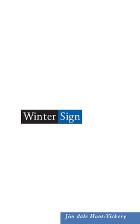 Winter Sign
Jim Dale Huot-Vickery
University of Minnesota Press, 1998 A journey into the soul of the coldest season. The locus of Jim dale Huot-Vickery’s life is a remote cabin in the northern wilderness of Minnesota’s Boundary Waters region. More often than not, it is winter here, a fierce, beautiful season that dominates all living things with its relentless cold grip. This is the inspiration for Winter Sign, the profound story of fifteen years of surviving the seven-month-long odyssey of winter in the far north. “We know parkas, mukluks, mittens, snowshoes, skis, and sled dogs,” Huot-Vickery writes. “Snow sparkles gold on cloudless winter mornings. There are shell-pink sunsets. Stars glimmer among northern lights. . . . For those of us who know this land, however, beauty is only part of the winter story. There are those long nights, those we rarely speak about, that surely and irrevocably shift the soul.”Against this backdrop, Huot-Vickery writes authoritatively on the ecology of the area and philosophically about winter’s probing of the human spirit. He explores the world of nature and the constant struggle for survival, including his own interactions with white-tailed deer and wolves.Huot-Vickery circles around paradoxes and themes that invade the land and his life: nature’s beauty and bounty pitted against danger and death; the challenge of self-reliance and the depths of isolation; loss and restoration. And always there is the unrelenting winter, filled with wonder and terror. At turns poignant and harrowing, Winter Sign explores the solitude of the dark night of the soul, and the sustenance and inspiration winter’s wild beauty provides. ISBN 0-8166-2969-2 Paper $15.95192 pages 5 x 8 NovemberTranslation inquiries: University of Minnesota Press
Winter Stars
Larry Levis
University of Pittsburgh Press, 1985 Since the appearance of his first book in 1972, Larry Levis has been one of the most original and most highly praised of contemporary American poets. In Winter Stars, a book of love poems and elegies, Levis engages in a process of relentless self-interrogation about his life, about losses and acceptances. What emerges is not merely autobiography, but a biography of the reader, a “representative life” of our time.
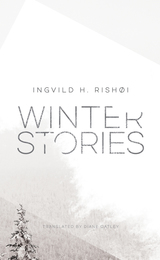 Winter Stories
Ingvild Rishøi
Seagull Books, 2018 In Winter Stories, Norwegian author Ingrid H. Rishøi gives us three contemporary tales about personal resilience in the face of adversity. We meet a teenager on the run from social services with her younger half-sister and half-brother in tow; a young single mother struggling to provide adequately for her daughter; and an ex-convict striving to overcome personal shortcomings and build a relationship with his son.
Driven by a fundamental need to secure and protect relationships with loved ones, Rishøi’s characters stumble, fall, and climb to their feet again—even though the deck inevitably seems to be stacked against them. Seemingly minor snags in their best-laid plans carry the risk of undermining everything with potentially life-altering consequences. What these stories illustrate, however, is how small victories and the unexpected compassion of virtual strangers can have a far-reaching and profound impact. With empathy and sensitivity, the poetic sensibility of Rishøi’s literary voice beautifully illuminates the fragile vulnerability of the human condition. In a time when the level of skepticism and distrust between people is rising, these stories remind us of the humanity that unites us all.
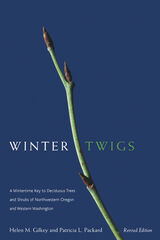 Winter Twigs, Revised Edition: A Wintertime Key to Deciduous Trees and Shrubs of Northwestern Oregon and Western Washington
Helen Gilkey
Oregon State University Press, 2001 Winter Twigs has long been respected and widely used as a unique guide for wintertime identification of the deciduous plants of northwestern Oregon and western Washington (many of the species covered are also found in British Columbia and Alaska). The first edition of this book has been used by thousands of botany students and other interested individuals to identify plants during the months that they lack the leaves and flowers that most field guides rely on. Intended for use by teachers, students, scientists, amateur botanists, and outdoor enthusiasts, Winter Twigs brings together in one convenient volume the information necessary to identify all of the native deciduous woody plants likely to be encountered in the region, as well as many of the more common escaped cultivated species, Also included are certain species which are normally evergreen but may be deciduous during severe winters. Covered are 82 species representing 35 genera of 17 plant families likely to be found between the Cascade mountains and Pacific Coast in Washington and Oregon as far south as the Umpqua divide, and keys to all species that can be readily identified by winter characteristics. The glossary of botanical terms and more than 100 line drawings that highlight the identifying features of various plants will be especially valuable to students and beginners. To make this new edition as accurate and up-to-date as possible, the nomenclature for 22 species has been updated to conform to the latest scientific literature, with contributions by the Oregon Vascular Plant Checklist Project.
Wintering: Poems
Megan Snyder-Camp
Tupelo Press, 2016 A handwritten court record offers a forgotten name, a baby cries in the archive: In Wintering, her second collection of poems, Megan Snyder-Camp composes a disruptive, archive-sourced poetry of witness that challenges the given story of the “Indian vocabularies,” indigenous language records Lewis and Clark gathered during their 1804-6 journey. Exploring whiteness, memory and language, Wintering is a book about the mark our hunger makes.
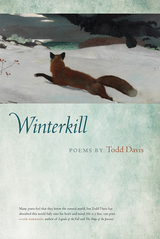 Winterkill
Todd Davis
Michigan State University Press, 2016 In Winterkill, Todd Davis, who, according to Gray’s Sporting Journal, “observes nature in the great tradition of Robert Frost, James Dickey, and Jim Harrison,” offers an unflinching portrait of the cycles of birth and death in the woods and streams of Pennsylvania, while never leaving behind the tragedies and joys of the human world. Fusing narrative and lyrical impulses, in his fifth book of poetry Davis seeks to address the living world through a lens of transformation. In poems of praise and sorrow that draw upon the classical Chinese rivers-and-mountains tradition, Davis chronicles the creatures of forest and sky, of streams and lakes, moving through cycles of fecundity and lack, paying witness to the fundamental processes of the earth that offer the possibility of regeneration, even resurrection. Meditations on subjects from native brook trout to the ants that scramble up a compost pile; from a young diabetic girl burning trash in a barrel to a neighbor’s denial of global warming; from an examination of the bone structure in a rabbit’s skull to a depiction of a boy who can name every bird by its far-off song, these are poems that both celebrate and lament the perfectly imperfect world that sustains us.
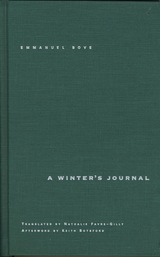 A Winter's Journal
Emmanuel Bove, translated by Nathalie Favre-Gilly and with an afterword by Keith Botsford
Northwestern University Press, 1997 Paris in the 1930s: Louis Grandeville has a beautiful wife, a nice home, a loyal servant, and a large circle of well-placed friends. His financial situation doesn't require him to work. Yet Louis is obsessed by the nagging reality that he never has and never will amount to anything. He believes his life is devoid of any affection or goal, filled instead with a thousand trifles intended to relieve its monotony, and populated with human beings he seeks out to avoid being alone but for whom he cares little.
Every few days for one winter, Louis writes down the details of his unhappy marriage. Although his wife, Madeleine, is the focal point of his journal, his painstakingly rendered analyses of her behavior tell us more about him than her, and about the harm two people can do to one another. Unsparing and insightful, A Winter's Journal remains one of the most devastating novels ever written on the self-destructive impulse present in all marriages.
 Winters of Discontent: The Winter Olympics and a Half Century of Protest and Resistance
Edited by Russell Field
University of Illinois Press, 2025 Every four years, the Winter Olympics become a focal point for activism and resistance. But in the modern era, mere bids to host the Games have sparked fierce opposition from groups motivated by local or global concerns. Russell Field edits a collection that charts the evolution of protest around the Winter Games and illuminates the issues at the heart of anti-Olympic activism. The essays collectively explore the shifting dynamics and power relations between the civic coalitions that pursue the Winter Olympics and the social movements that oppose their efforts. The contributors look at specific Games impacted by dissent and probe the issues that swirled around failed and withdrawn bids. In addition, contributions on the contemporary Olympics describe current or future bids while delving into the campaigns demanding host nations pay attention to economic, social, humanitarian, and environmental concerns. A first-of-its-kind collection, Winters of Discontent profiles the wide range of activists and social movements that have organized against the Winter Olympics.
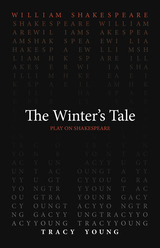 The Winter's Tale
William Shakespeare
Arizona Center for Medieval and Renaissance Studies, 2023 Tracy Young offers a new version of Shakespeare’s difficult tale of jealousy and redemption.
The Winter’s Tale is one of Shakespeare’s most challenging explorations of redemption and rebirth. Driven by extreme jealousy, Leontes, the King of Sicily, accuses his wife Hermione of infidelity and orders his newborn daughter to be abandoned. Sixteen years later, Leontes must reckon with the consequences of his rash decisions. Tracy Young’s version of The Winter’s Tale transforms the theatergoing experience from Shakespeare’s time to ours. This translation updates Shakespeare’s language, wordplay, and wit to engage audiences the way they would have been engaged in the early modern theater.
This translation of The Winter’s Tale was written as part of the Oregon Shakespeare Festival’s Play On! project, which commissioned new translations of thirty-nine Shakespeare plays. These translations present work from “The Bard” in language accessible to modern audiences while never losing the beauty of Shakespeare’s verse. Enlisting the talents of a diverse group of contemporary playwrights, screenwriters, and dramaturges from diverse backgrounds, this project reenvisions Shakespeare for the twenty-first century. These volumes make these works available for the first time in print—a new First Folio for a new era.
Winterthur Portfolio, volume 55 number 1 (Spring 2021)
The University of Chicago Press
University of Chicago Press Journals, 2021 This is volume 55 issue 1 of Winterthur Portfolio. Winterthur Portfolio fosters knowledge of the North American past by publishing articles on material culture and the historical contexts within which artifacts developed. The journal presents interdisciplinary scholarship that critically engages art history, history, geography, ethnology, archaeology, anthropology, craft, design, and literature. It publishes articles that are analytical and synthetic rather than descriptive, and it encourages submissions by scholars underrepresented in material culture studies.
Winterthur Portfolio, volume 55 number 23 (Summer/Autumn 2021)
The University of Chicago Press
University of Chicago Press Journals, 2021 This is volume 55 issue 23 of Winterthur Portfolio. Winterthur Portfolio fosters knowledge of the North American past by publishing articles on material culture and the historical contexts within which artifacts developed. The journal presents interdisciplinary scholarship that critically engages art history, history, geography, ethnology, archaeology, anthropology, craft, design, and literature. It publishes articles that are analytical and synthetic rather than descriptive, and it encourages submissions by scholars underrepresented in material culture studies.
Winterthur Portfolio, volume 55 number 4 (Winter 2021)
The University of Chicago Press
University of Chicago Press Journals, 2021 This is volume 55 issue 4 of Winterthur Portfolio. Winterthur Portfolio fosters knowledge of the North American past by publishing articles on material culture and the historical contexts within which artifacts developed. The journal presents interdisciplinary scholarship that critically engages art history, history, geography, ethnology, archaeology, anthropology, craft, design, and literature. It publishes articles that are analytical and synthetic rather than descriptive, and it encourages submissions by scholars underrepresented in material culture studies.
Winterthur Portfolio, volume 56 number 1 (Spring 2022)
The University of Chicago Press
University of Chicago Press Journals, 2022 This is volume 56 issue 1 of Winterthur Portfolio. Winterthur Portfolio fosters knowledge of the North American past by publishing articles on material culture and the historical contexts within which artifacts developed. The journal presents interdisciplinary scholarship that critically engages art history, history, geography, ethnology, archaeology, anthropology, craft, design, and literature. It publishes articles that are analytical and synthetic rather than descriptive, and it encourages submissions by scholars underrepresented in material culture studies.
Winterthur Portfolio, volume 56 number 23 (Summer/Autumn 2022)
The University of Chicago Press
University of Chicago Press Journals, 2022 This is volume 56 issue 23 of Winterthur Portfolio. Winterthur Portfolio fosters knowledge of the North American past by publishing articles on material culture and the historical contexts within which artifacts developed. The journal presents interdisciplinary scholarship that critically engages art history, history, geography, ethnology, archaeology, anthropology, craft, design, and literature. It publishes articles that are analytical and synthetic rather than descriptive, and it encourages submissions by scholars underrepresented in material culture studies.
Winterthur Portfolio, volume 56 number 4 (Winter 2022)
The University of Chicago Press
University of Chicago Press Journals, 2022 This is volume 56 issue 4 of Winterthur Portfolio. Winterthur Portfolio fosters knowledge of the North American past by publishing articles on material culture and the historical contexts within which artifacts developed. The journal presents interdisciplinary scholarship that critically engages art history, history, geography, ethnology, archaeology, anthropology, craft, design, and literature. It publishes articles that are analytical and synthetic rather than descriptive, and it encourages submissions by scholars underrepresented in material culture studies.
Winterthur Portfolio, volume 57 number 1 (Spring 2023)
The University of Chicago Press
University of Chicago Press Journals, 2023 This is volume 57 issue 1 of Winterthur Portfolio. Winterthur Portfolio fosters knowledge of the North American past by publishing articles on material culture and the historical contexts within which artifacts developed. The journal presents interdisciplinary scholarship that critically engages art history, history, geography, ethnology, archaeology, anthropology, craft, design, and literature. It publishes articles that are analytical and synthetic rather than descriptive, and it encourages submissions by scholars underrepresented in material culture studies.
Winterthur Portfolio, volume 57 number 23 (Summer/Autumn 2023)
The University of Chicago Press
University of Chicago Press Journals, 2023 This is volume 57 issue 23 of Winterthur Portfolio. Winterthur Portfolio fosters knowledge of the North American past by publishing articles on material culture and the historical contexts within which artifacts developed. The journal presents interdisciplinary scholarship that critically engages art history, history, geography, ethnology, archaeology, anthropology, craft, design, and literature. It publishes articles that are analytical and synthetic rather than descriptive, and it encourages submissions by scholars underrepresented in material culture studies.
Winterthur Portfolio, volume 57 number 4 (Winter 2023)
The University of Chicago Press
University of Chicago Press Journals, 2023 This is volume 57 issue 4 of Winterthur Portfolio. Winterthur Portfolio fosters knowledge of the North American past by publishing articles on material culture and the historical contexts within which artifacts developed. The journal presents interdisciplinary scholarship that critically engages art history, history, geography, ethnology, archaeology, anthropology, craft, design, and literature. It publishes articles that are analytical and synthetic rather than descriptive, and it encourages submissions by scholars underrepresented in material culture studies.
Winterthur Portfolio, volume 58 number 1 (Spring 2024)
The University of Chicago Press
University of Chicago Press Journals, 2024 This is volume 58 issue 1 of Winterthur Portfolio. Winterthur Portfolio fosters knowledge of the North American past by publishing articles on material culture and the historical contexts within which artifacts developed. The journal presents interdisciplinary scholarship that critically engages art history, history, geography, ethnology, archaeology, anthropology, craft, design, and literature. It publishes articles that are analytical and synthetic rather than descriptive, and it encourages submissions by scholars underrepresented in material culture studies.
Winterthur Portfolio, volume 58 number 23 (Summer/Autumn 2024)
The University of Chicago Press
University of Chicago Press Journals, 2024 This is volume 58 issue 23 of Winterthur Portfolio. Winterthur Portfolio fosters knowledge of the North American past by publishing articles on material culture and the historical contexts within which artifacts developed. The journal presents interdisciplinary scholarship that critically engages art history, history, geography, ethnology, archaeology, anthropology, craft, design, and literature. It publishes articles that are analytical and synthetic rather than descriptive, and it encourages submissions by scholars underrepresented in material culture studies.
Winterthur Portfolio, volume 58 number 4 (Winter 2024)
The University of Chicago Press
University of Chicago Press Journals, 2024 This is volume 58 issue 4 of Winterthur Portfolio. Winterthur Portfolio fosters knowledge of the North American past by publishing articles on material culture and the historical contexts within which artifacts developed. The journal presents interdisciplinary scholarship that critically engages art history, history, geography, ethnology, archaeology, anthropology, craft, design, and literature. It publishes articles that are analytical and synthetic rather than descriptive, and it encourages submissions by scholars underrepresented in material culture studies.
Winterthur Portfolio, volume 59 number 1 (Spring 2025)
The University of Chicago Press
University of Chicago Press Journals, 2025 This is volume 59 issue 1 of Winterthur Portfolio. Winterthur Portfolio fosters knowledge of the North American past by publishing articles on material culture and the historical contexts within which artifacts developed. The journal presents interdisciplinary scholarship that critically engages art history, history, geography, ethnology, archaeology, anthropology, craft, design, and literature. It publishes articles that are analytical and synthetic rather than descriptive, and it encourages submissions by scholars underrepresented in material culture studies.
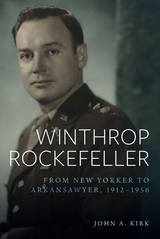 Winthrop Rockefeller: From New Yorker to Arkansawyer, 1912-1956
John A. Kirk
University of Arkansas Press, 2022 Winner, 2024 J. G. Ragsdale Book Award, Arkansas Historical Association Winner, 2024 Booker Worthen Literary Prize Why did Winthrop Rockefeller, scion of one of the most powerful families in American history, leave New York for an Arkansas mountaintop in the 1950s? In this richly detailed biography of the former Arkansas governor, John A. Kirk delves into the historical record to fully unravel that mystery for the first time. Kirk pursues clues threaded throughout Rockefeller’s life, tracing his family background, childhood, and education; his rise in the oil industry from roustabout to junior executive; his military service in the Pacific during World War II, including his involvement in the battles of Guam, Leyte, and Okinawa; his postwar work in race relations, health, education, and philanthropy; his marriage to and divorce from Barbara “Bobo” Sears; and the birth of his only child, future Arkansas lieutenant governor Win Paul Rockefeller. This careful examination of Winthrop Rockefeller’s first forty-four years casts a powerful new light on his relationship with his adopted state, where his legacy continues to be felt more than half a century after his governorship.
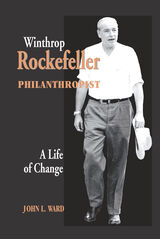 Winthrop Rockefeller, Philanthropist: A Life of Change
John Ward
University of Arkansas Press, 2004 As grandson of oil tycoon John D. Rockefeller Sr. and son of philanthropist John D. Jr., Winthrop Rockefeller was born into one of the most affluent and influential families in the world. But he was a nonconformist and often felt isolated from the rest of his family. Still, he amazed many when he left the New York elite for a farm in rural Arkansas, where he would ultimately serve two terms as governor and create a philanthropic legacy all his own. In Winthrop Rockefeller, Philanthropist, John L. Ward draws from his years as Rockefeller’s speech writer and campaign advisor to create a remarkably readable and comprehensive narrative. Ward provides valuable insights into Rockefeller’s complicated relationships with his father and brothers and convincingly argues that Rockefeller’s extraordinarily innovative approach to philanthropy changed the way Arkansas was viewed by its citizens and by the rest of the world. This book is a must-read for anyone interested in twentieth-century philanthropy.
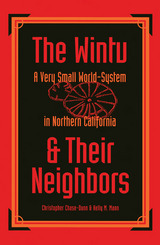 The Wintu and Their Neighbors: A Very Small World-System in Northern California
Christopher Chase-Dunn
University of Arizona Press, 1998 On the cutting edge of world-systems theory comes The Wintu and Their Neighbors, the first case study to compare and contrast systematically an indigenous Native American society with the modern world at large. Using an interdisciplinary approach that combines sociology, anthropology, political science, geography, and history, Christopher Chase-Dunn and Kelly M. Mann have scoured the archaeological record of the Wintu, an aboriginal people without agriculture, metallurgy, or class structure who lived in the wooded valleys and hills of northern California. By studying the household composition, kinship, and trade relations of the Wintu, they call into question some of the basic assumptions of prior sociological theory and analysis.
Chase-Dunn and Mann argue that Immanuel Wallerstein's world-systems perspective, originally applied only to the study of modern capitalistic societies, can also be applied to the study of the social, economic, and political relationships in small stateless societies. They contend that, despite the fact that the Wintu appear on the surface to have been a household-based society, this indigenous group was in fact involved in a myriad of networks of interaction, which resulted in intermarriage and which extended for many miles around the region. These networks, which were not based on the economic dominance of one society over another—a concept fundamental to Wallerstein's world-systems theory—led to the eventual expansion of the Wintu as a cultural group.
Thus, despite the fact that the Wintu did not behave like a modern society—lacking wealth accumulation, class distinctions, and cultural dominance—Chase-Dunn and Mann insist that the Wintu were involved in a world-system and argue, therefore, that the concept of the "minisystem" should be discarded. They urge other scholars to employ this comparative world-systems perspective in their research on stateless societies.
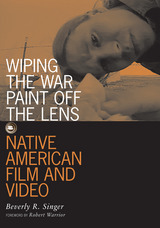 Wiping the War Paint off the Lens: Native American Film and Video
Beverly R. Singer
University of Minnesota Press, 2001 The first comprehensive exploration of Native American filmmaking and video production. Native Americans have thrown themselves into filmmaking since the mid-1970s, producing hundreds of films and videos, and their body of work has had great impact on Native cultures and filmmaking itself. With their cameras, they capture the lives of Native people, celebrating community, ancestral lifeways, and identity. Not only artistic statements, the films are archives that document rich and complex Native communities and counter mainstream media portrayals. Wiping the War Paint off the Lens traces the history of Native experiences as subjects, actors, and creators, and develops a critical framework for approaching Native work. Singer positions Native media as part of a larger struggle for "cultural sovereignty"-the right to maintain and protect cultures and traditions. Taking it out of a European-American context, she reframes the discourse of filmmaking, exploring oral histories and ancient lifeways inform Native filmmaking and how it seeks to heal the devastation of the past. Singer’s approach is both cultural and personal, provides both historical views and close textual readings, and may well set the terms of the critical debate on Native filmmaking.
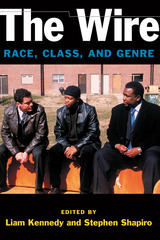 The Wire: Race, Class, and Genre
Edited by Liam Kennedy and Stephen Shapiro
University of Michigan Press, 2012 Few other television series have received as much academic, media, and fan celebration as The Wire, which has been called the best dramatic series ever created. The show depicts the conflict between Baltimore's police and criminals to raise a warning about race; drug war policing; deindustrialization; and the inadequacies of America’s civic, educational, and political institutions. The show's unflinching explorations of a city in crisis and its nuanced portrayals of those affected make it a show all about race and class in America. The essays in this volume offer a range of astute critical responses to this television phenomenon. More consistently than any other crime show of its generation, The Wire challenges viewers' perceptions of the racialization of urban space and the media conventions that support this. The Wire reminds us of just how remarkably restricted the grammar of race is on American television and related media, and of the normative codings of race---as identity, as landscape---across urban narratives, from documentary to entertainment media.
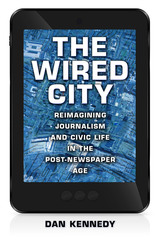 The Wired City: Reimagining Journalism and Civic Life in the Post-Newspaper Age
Dan Kennedy
University of Massachusetts Press, 2013 In The Wired City, Dan Kennedy tells the story of the New Haven Independent, a nonprofit community website in Connecticut that is at the leading edge of reinventing local journalism. Through close attention to city government, schools, and neighborhoods, and through an ongoing conversation with its readers, the Independent's small staff of journalists has created a promising model of how to provide members of the public with the information they need in a self-governing society.
Although the Independent is the principal subject of The Wired City, Kennedy examines a number of other online news projects as well, including nonprofit organizations such as Voiceof San Diego and the Connecticut Mirror and for-profit ventures such as the Batavian, Baristanet, and CT News Junkie. Where legacy media such as major city newspapers are cutting back on coverage, entrepreneurs are now moving in to fill at least some of the vacuum.
The Wired City includes the perspectives of journalists, activists, and civic leaders who are actively re-envisioning how journalism can be meaningful in a hyperconnected age of abundant news sources. Kennedy provides deeper context by analyzing the decline of the newspaper industry in recent years and, in the case of those sites choosing such a path, the uneasy relationship between nonprofit status and the First Amendment.
At a time of pessimism over the future of journalism, The Wired City offers hope. What Kennedy documents is not the death of journalism but rather the uncertain and sometimes painful early stages of rebirth.
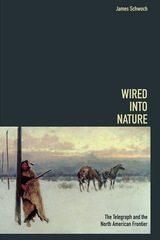 Wired into Nature: The Telegraph and the North American Frontier
James Schwoch
University of Illinois Press, 2018 The completion of the Transcontinental Telegraph in 1861 completed telegraphy's mile-by-mile trek across the West. In addition to linking the coasts, the telegraph represented an extraordinary American effort in many fields of endeavor to know, act upon, and control a continent. Merging new research with bold interpretation, James Schwoch details the unexplored dimensions of the frontier telegraph and its impact. The westward spread of telegraphy entailed encounters with environments that challenged Americans to acquire knowledge of natural history, climate, and a host of other fields. Telegraph codes and ciphers, meanwhile, became important political, military, and economic secrets. Schwoch shows how the government's use of commercial networks drove a relationship between the two sectors that served increasingly expansionist aims. He also reveals the telegraph's role in securing high ground and encouraging surveillance. Both became vital aspects of the American effort to contain, and conquer, the West's indigenous peoples—and part of a historical arc of concerns about privacy, data gathering, and surveillance that remains pertinent today. Entertaining and enlightening, Wired into Nature explores an unknown history of the West.
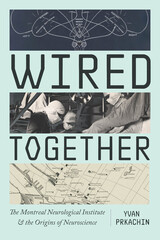 Wired Together: The Montreal Neurological Institute and the Origins of Neuroscience
Yvan Prkachin
University of Chicago Press Examines the role of an influential neurological institute in shaping a new, interdisciplinary science—neuroscience—and advancing it worldwide.
Wired Together explains the rise of neuroscience by tracing the history of the Montreal Neurological Institute (MNI) and the men and women who transformed it into neuroscience’s most innovative and productive research site. Opened by neurosurgeon Wilder Penfield in 1934, the MNI pioneered the surgical treatment of epilepsy and transformed the operating theater into a new kind of scientific laboratory for investigating the functions of the brain. But more than that, the MNI became a crucial site for forming new interdisciplinary practices. These involved, as Yvan Prkachin puts it, wiring together new assemblies of physicians, surgeons, and scientists into a growing network that made possible the emergence of an interdisciplinary science of the brain.
Wired Together also traces how the MNI and its network of scientists spread this new interdisciplinary neuroscience to the rest of the world. Prkachin uncovers the surprising history of some of the most important neuroscientific organizations, discoveries, theories, and instruments from their beginnings in Montreal through the complex international networks of the post-war sciences. In doing so, he tells the stories of the most crucial and least understood characters from early neuroscience—such as Brenda Milner, Donald Hebb, Herbert Jasper, Molly Harrower, and David Hubel—as well as the surprising origins of scientific practices and ideas like sensory deprivation, multiple forms of memory, and artificial neural networks.
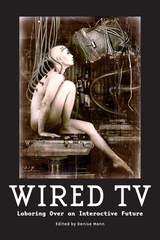 Wired TV: Laboring Over an Interactive Future
Mann, Denise
Rutgers University Press, 2014 This collection looks at the post–network television industry’s heady experiments with new forms of interactive storytelling—or wired TV—that took place from 2005 to 2010 as the networks responded to the introduction of broadband into the majority of homes and the proliferation of popular, participatory Web 2.0 companies like Facebook, YouTube, and Twitter. Contributors address a wide range of issues, from the networks’ sporadic efforts to engage fans using transmedia storytelling to the production inefficiencies that continue to dog network television to the impact of multimedia convergence and multinational, corporate conglomeration on entrepreneurial creativity. With essays from such top scholars as Henry Jenkins, John T. Caldwell, and Jonathan Gray and from new and exciting voices emerging in this field, Wired TV elucidates the myriad new digital threats and the equal number of digital opportunities that have become part and parcel of today’s post-network era. Readers will quickly recognize the familiar television franchises on which the contributors focus— including Lost, The Office, Entourage, Battlestar Gallactica, The L Word, and Heroes—in order to reveal their impact on an industry in transition. While it is not easy for vast bureaucracies to change course, executives from key network divisions engaged in an unprecedented period of innovation and collaboration with four important groups: members of the Hollywood creative community who wanted to expand television’s storytelling worlds and marketing capabilities by incorporating social media; members of the Silicon Valley tech community who were keen to rethink television distribution for the digital era; members of the Madison Avenue advertising community who were eager to rethink ad-supported content; and fans who were enthusiastic and willing to use social media story extensions to proselytize on behalf of a favorite network series. In the aftermath of the lengthy Writers Guild of America strike of 2007/2008, the networks clamped down on such collaborations and began to reclaim control over their operations, locking themselves back into an aging system of interconnected bureaucracies, entrenched hierarchies, and traditional partners from the past. What’s next for the future of the television industry? Stay tuned—or at least online. Contributors: Vincent Brook, Will Brooker, John T. Caldwell, M. J. Clarke, Jonathan Gray, Henry Jenkins, Derek Johnson, Robert V. Kozinets, Denise Mann, Katynka Z. Martínez, and Julie Levin Russo
 Wired Wisdom: How to Age Better Online
Eszter Hargittai and John Palfrey
University of Chicago Press, 2025 A surprising window into the online lives of people sixty and over—offering essential insights, no matter your age.
Many popular accounts say the older you are, the greater your tech struggles. And it’s worrying to think of loved ones emailing cringe-worthy misinformation, falling for phishing attacks, or becoming lonelier with increasing time spent online.
But in their eye-opening book on the internet’s fastest-growing demographic, researchers Eszter Hargittai and John Palfrey offer a more nuanced picture—debunking common myths about older adults’ internet use to offer hope and a necessary call to action. Incorporating original interviews and survey results from thousands of people sixty and over, Wired Wisdom shows that many, in fact, use technology in ways that put younger peers to shame. Over-sixties are often nimble online and quicker to abandon social media platforms that don’t meet their needs. Despite being targeted more often, they also may be less likely to fall for scams than younger peers. And fake news actually fools fewer people over sixty, who have far more experience evaluating sources and detecting propaganda. Still, there are unseen risks and missed opportunities for this group. Hargittai and Palfrey offer practical advice and show that our stereotypes can be hurdles that keep us from building intergenerational support communities, helping loved ones adopt new technology that may improve their lives, and thriving together online.
 Wired Wisdom: How to Age Better Online
Eszter Hargittai and John Palfrey
University of Chicago Press, 2025 This is an auto-narrated audiobook version of this book.
A surprising window into the online lives of people sixty and over—offering essential insights, no matter your age.
Many popular accounts say the older you are, the greater your tech struggles. And it’s worrying to think of loved ones emailing cringe-worthy misinformation, falling for phishing attacks, or becoming lonelier with increasing time spent online.
But in their eye-opening book on the internet’s fastest-growing demographic, researchers Eszter Hargittai and John Palfrey offer a more nuanced picture—debunking common myths about older adults’ internet use to offer hope and a necessary call to action. Incorporating original interviews and survey results from thousands of people sixty and over, Wired Wisdom shows that many, in fact, use technology in ways that put younger peers to shame. Over-sixties are often nimble online and quicker to abandon social media platforms that don’t meet their needs. Despite being targeted more often, they also may be less likely to fall for scams than younger peers. And fake news actually fools fewer people over sixty, who have far more experience evaluating sources and detecting propaganda. Still, there are unseen risks and missed opportunities for this group. Hargittai and Palfrey offer practical advice and show that our stereotypes can be hurdles that keep us from building intergenerational support communities, helping loved ones adopt new technology that may improve their lives, and thriving together online.
Wireless Communications Circuits and Systems
Yichuang Sun
The Institution of Engineering and Technology, 2004 This book presents a state of the art review of integrated circuits, systems and transceivers for wireless and mobile communications. Contributions from world-class researchers focus upon the most recent developments in key RF, IF and baseband components and subsystems and transceiver architecture in CMOS technology. Adopting a top-down approach from wireless communications systems, mobile terminals and transceivers, to constituent components, this book covers the whole range of baseband, IF and RF issues in a systematic way. Circuit and system techniques for design and implementation of reconfigurable low voltage and low power single-chip CMOS transceivers for both mobile cellular and wireless LAN applications are included.
Wireless Dada: Telegraphic Poetics in the Avant-Garde
Kurt Beals
Northwestern University Press, 2020 Wireless Dada: Telegraphic Poetics in the Avant-Garde demonstrates that the poetics of the Dada movement was profoundly influenced by the telegraph and the technological and social transformations that it brought about in the nineteenth and early twentieth centuries. While telegraphy’s impact on Italian Futurism and German Expressionism is widely acknowledged, its formative role in Dada poetics has been largely neglected. Drawing on media history and theory, avant-garde studies, and German literary studies, Kurt Beals shows how the telegraph and the cultural discourses that surrounded it shaped the radical works of this seminal avant-garde movement. The “nonsense” strain in Dada is frequently seen as a response to the senseless violence of the First World War. Beals argues that it was not just the war that turned Dada poetry into a jumble of senseless signals—it was also the wireless.
Wireless Medical Sensor Networks for IoT-based eHealth
Fadi Al-Turjman
The Institution of Engineering and Technology, 2020 Internet of Things (IoT) enabled technology is evolving healthcare from conventional hub-based systems to more personalized eHealth systems, enabling faster and safer preventive care, lower overall cost, improved patient-centric practice and enhanced sustainability. Efficient IoT-enabled eHealth systems can be realized by providing highly customized access to rich medical information and efficient clinical decisions to each individual with unobtrusive monitoring. Wireless medical sensor networks (WMSNs) are at the heart of this concept, and their development is a key issue if such a concept is to achieve its potential.
Wireless Mesh Networks for IoT and Smart Cities: Technologies and applications
Luca Davoli
The Institution of Engineering and Technology, 2022 Wireless mesh networks (WMNs) are wireless communication networks organized in a mesh topology with radio capabilities. These networks can self-form and self-heal and are not restricted to a specific technology or communication protocol. They provide flexible yet reliable connectivity that cellular networks cannot deliver. Thanks to technological advances in machine learning, software defined radio, UAV/UGV, big data, IoT and smart cities, wireless mesh networks have found much renewed interest for communication network applications.
Wireless Power Transfer Technologies: Theory and technologies
Naoki Shinohara
The Institution of Engineering and Technology, 2024 Wireless Power Transfer (WPT) serves to transfer power from a grid or storage unit to a device without the need for cable connections. This can be performed by induction, as well as by using radio or microwaves.
Wireless Power Transfer: Theory, technology, and applications
Naoki Shinohara
The Institution of Engineering and Technology, 2018 Wireless Power Transfer (WPT) enables power to be transferred from a grid or storage unit to a device without the need for cable connections. This can be performed by inductive coupling of magnetic fields as well as by direct radiative transfer via beams of electromagnetic waves, commonly radiowaves, microwaves or lasers. Inductive coupling is the most widely used wireless technology with applications including charging handheld devices, RFID tags, chargers for implantable medical devices, and proposed systems for charging electric vehicles. Applications of radiative power transfer include solar power satellites and wireless powered drone aircraft.
Wireless Receiver Design for Digital Communications
Kevin McClaning
The Institution of Engineering and Technology, 2012 Practical lessons and approaches in radio receiver design for wireless communication systems are the hallmarks of Wireless Receiver Design for Digital Communications, 2nd Edition. Decades of experience 'at the bench' are collected within and the book acts as a virtual replacement for a mentor who teaches basic concepts from a practical perspective and has the war stories that help their 'apprentice' avoid the mistakes of the past.
Wireless: The Crucial Decade: History of the British wireless industry 1924-34
Gordon Bussey
The Institution of Engineering and Technology, 1990 The crucial decade for the development of the domestic wireless was 1924-34. At the beginning of the period most receivers in Britain were crystal sets, but by the end nearly all sets were on the mains, using valves and mostly with superhet circuits-broadly the same as those in use today.
Wiring The Writing Center
Eric Hobson
Utah State University Press, 1998 Published in 1998, Wiring the Writing Center was one of the first few books to address the theory and application of electronics in the college writing center. Many of the contributors explore particular features of their own "wired" centers, discussing theoretical foundations, pragmatic choices, and practical strengths. Others review a range of centers for the approaches they represent. A strong annotated bibliography of signal work in the area is also included.
Wisconsin: A History
Robert C. Nesbit; Revised and updated by William F. Thompson
University of Wisconsin Press, 2004 Robert Nesbit’s classic single-volume history of Wisconsin was expanded by Wisconsin State Historian William F. Thompson to include the period from 1940 to the late 1980s, along with updated bibliographies and appendices.
First paperback edition.
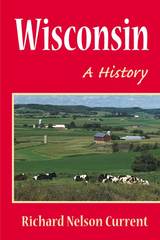 Wisconsin: A HISTORY
Richard Nelson Current
University of Illinois Press, 1977 A haven for summer tourists and winter sport enthusiasts, Wisconsin is famed for its physical beauty and its prodigious production of cheese and dairy products. Richard Nelson Current's compact history reveals the colorful past of America's Dairyland, from early explorers and gangsters to sports heroes and cheeseheads.
Both the Ringling Brothers' "World's Greatest Shows" and Barnum & Bailey's "Greatest Show on Earth" originated in Wisconsin, along with the typewriter, Johnson's Wax, and the first automatic assembly line (for manufacturing automobile frames). Wisconsin inventors contributed to the mechanization of American farms by developing harvesters, reapers, cultivators, threshers, and other machinery. Sen. Robert M. ("Fighting Bob") La Follette brought progressive reform to the state; a few decades later another Wisconsin native, Joseph McCarthy, revealed his agenda as a U.S. senator.
The Gideons, who place Bibles in hotel room nightstands, got their start in Wisconsin, and the state's factories produced most of the 107 steam shovels that dug the Panama Canal. Even before American Motors in Kenosha became Wisconsin's largest employer, Wisconsinites were responsible for such car-related developments as the first four-wheel-drive vehicle and an early tire-patching kit.
To football fans, the capital of Wisconsin is Green Bay, where in 1919 Earl Louis Lambeau organized the Packers. Even during the team's fifteen-year losing streak, Green Bay consisted, as one reporter observed, of "nearly 50,000 wild-eyed maniacs [who] know more about football than any other 50,000 people on the face of the earth."
Fast-paced and entertaining, Current's history chronicles how Wisconsin's homegrown ideas, from the "Wisconsin Idea" of efficient state government to ski-tows and speedometers, made their way into the broader marketplace of American culture.
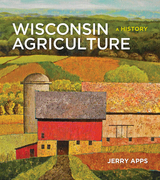 Wisconsin Agriculture: A History
Jerry Apps
Wisconsin Historical Society Press, 2015 "I'm embarrassed to say I thought I knew anything substantial about Wisconsin agriculture or its history before I read this book. 'Wisconsin Agriculture' should be required reading in history classes from high school to the collegiate level. It makes me thankful that Jerry Apps has such a sense of commitment to Wisconsin's agricultural heritage--and to getting the story right." --Pam Jahnke, Farm Director, Wisconsin Farm Report Radio Wisconsin has been a farming state from its very beginnings. And though it's long been known as "the Dairy State," it produces much more than cows, milk, and cheese. In fact, Wisconsin is one of the most diverse agricultural states in the nation. The story of farming in Wisconsin is rich and diverse as well, and the threads of that story are related and intertwined. In this long-awaited volume, celebrated rural historian Jerry Apps examines everything from the fundamental influences of landscape and weather to complex matters of ethnic and pioneer settlement patterns, changing technology, agricultural research and education, and government regulations and policies. Along with expected topics, such as the cranberry industry and artisan cheesemaking, "Wisconsin Agriculture" delves into beef cattle and dairy goats, fur farming and Christmas trees, maple syrup and honey, and other specialty crops, including ginseng, hemp, cherries, sugar beets, mint, sphagnum moss, flax, and hops. Apps also explores new and rediscovered farming endeavors, from aquaculture to urban farming to beekeeping, and discusses recent political developments, such as the 2014 Farm Bill and its ramifications. And he looks to the future of farming, contemplating questions of ethical growing practices, food safety, sustainability, and the potential effects of climate change. Featuring first-person accounts from the settlement era to today, along with more than 200 captivating photographs, "Wisconsin Agriculture" breathes life into the facts and figures of 150 years of farming history and provides compelling insights into the state's agricultural past, present, and future.
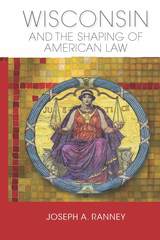 Wisconsin and the Shaping of American Law
Joseph A. Ranney
University of Wisconsin Press, 2017 State laws affect nearly every aspect of our daily lives—our safety, personal relationships, and business dealings—but receive less scholarly attention than federal laws and courts. Joseph A. Ranney looks at how state laws have evolved and shaped American history, through the lens of the historically influential state of Wisconsin.
Organized around periods of social need and turmoil, the book considers the role of states as legal laboratories in establishing American authority west of the Appalachians, in both implementing and limiting Jacksonian reforms and in navigating legal crises before and during the Civil War—including Wisconsin's invocation of sovereignty to defy federal fugitive slave laws. Ranney also surveys judicial revolts, the reforms of the Progressive era, and legislative responses to struggles for civil rights by immigrants, women, Native Americans, and minorities in the nineteenth and twentieth centuries. Since the 1960s, battles have been fought at the state level over such issues as school vouchers, voting, and abortion rights.
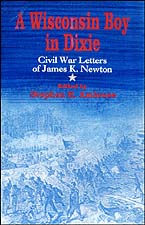 A Wisconsin Boy in Dixie: Civil War Letters of James K. Newton
Selected and Edited by Stephen E. Ambrose
University of Wisconsin Press, 1995 “Unlike many of his fellows, [James Newton] was knowledgeable, intuitive, and literate; like many of his fellows he was cast into the role of soldier at only eighteen years of age. He was polished enough to write drumhead and firelight letters of fine literary style. It did not take long for this farm boy turned private to discover the grand design of the conflict in which he was engaged, something which many of the officers leading the armies never did discover.”—Victor Hicken, Journal of the Illinois State Historical Society
“When I wrote to you last I was at Madison with no prospect of leaving very soon, but I got away sooner than I expected to.” So wrote James Newton upon leaving Camp Randall for Vicksburg in 1863 with the Fourteenth Wisconsin Volunteer Infantry. Newton, who had been a rural schoolteacher before he joined the Union army in 1861, wrote to his parents of his experiences at Shiloh, Corinth, Vicksburg, on the Red River, in Missouri, at Nashville, at Mobile, and as a prisoner of war. His letters, selected and edited by noted historian Stephen E. Ambrose, reveal Newton as a young man who matured in the war, rising in rank from private to lieutenant.
A Wisconsin Boy in Dixie reveals Newton as a young man who grew to maturity through his Civil War experience, rising in rank from private to lieutenant. Writing soberly about the less attractive aspects of army life, Newton's comments on fraternizing with the Rebs, on officers, and on discipline are touched with a sense of humor—"a soldier's best friend," he claimed. He also became sensitive to the importance of political choices. After giving Lincoln the first vote he had ever cast, Newton wrote: "In doing so I felt that I was doing my country as much service as I have ever done on the field of battle."
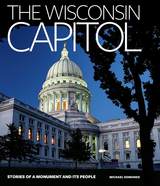 The Wisconsin Capitol: Stories of a Monument and Its People
Michael Edmonds
Wisconsin Historical Society Press, 2017 On the occasion of the Capitol’s centennial in 2017, this book tells the remarkable story of the building—in all its incarnations—and the people who made history beneath its dome. The book covers the creation of the territorial capitol in 1837, the construction of the second capitol in the 1860s (and the fire that almost completely destroyed it in 1904), the eleven-year construction project that completed the third capitol in 1917, and the extensive conservation project of the 1990s that restored the building to its grandeur. Supporting the framework of this architectural history are colorful stories about the people who shaped Wisconsin from within the Capitol—attorneys, senators, and governors (from Henry Dodge to Scott Walker), as well as protesters, reformers, secretaries, tour guides, custodians, and even Old Abe, the Capitol’s resident eagle. Combining historical photographs with modern, full-color architectural photos, The Wisconsin Capitol provides fascinating details about the building, while also emphasizing the importance of the Capitol in Wisconsin’s storied history.
Wisconsin Chippewa Myths & Tales: And Their Relation to Chippewa Life
Victor Barnouw
University of Wisconsin Press, 1979 Wisconsin Chippewa Myths & Tales, originally published in 1977, was the first collection of Chippewa folklore to provide a comparative and sociological context for the tales. These myths and tales were recorded between 1941 and 1944 by four young field workers who later became prominent anthropologists: Joseph B. Casagrande, Ernestine Friedl, Robert E. Ritzenthaler, and Victor Barnouw himself. The tales—which include stories of tricksters, animals, magical powers, and cannibal ice-giants—were told primarily by five members of the Lac Court Oreilles and Lac du Flambeau bands of Chippewa: John Mink, Prosper Guibord, Delia Oshogay, Tom Badger, and Julia Badger. Wisconsin Chippewa Myths & Tales is read as much for its fascinating stories as for its scholarship.
Wisconsin Cocktails
Jeanette Hurt
University of Wisconsin Press, 2020 Cocktails have always had a stronghold in America’s Dairyland. This highly illustrated volume uncovers the true stories behind the state’s obsession with brandy, ice cream drinks, and a smorgasbord of garnishes.
Beyond delving into mythic origins of several classic creations, Jeanette Hurt introduces a new generation of cocktails that offer a spin on standard concoctions. She explores the state’s unique farm-to-table ethos influenced by an abundance of locally sourced ingredients. Also included are a wealth of interviews with notable mixologists, sharing numerous favorite recipes for specialty pick-me-ups that connoisseurs and home bartenders alike will be clamoring to try. A definitive account of the beverages we love, Wisconsin Cocktails insists we order our Old Fashioneds the right way—with brandy.
 Wisconsin Dells
Jonathan C. Harrington
Research Publishers, 2006 Wisconsin Dells (a case study); published in 2007; 5 pages
Wisconsin Dells is a resort and entertainment center in south central Wisconsin and one of the Midwest's favorite vacation destinations. In summer, people come for its water parks and amphibious tours. In winter, people come for cross-country skiing and snowmobiling. Indoor attractions are open year-round.
Wisconsin Dells business owners develop marketing plans for drawing visitors to the area. To answer questions about their customers, they turn to Chamberlain Research Consultants, a marketing research firm headquartered in Madison, Wisconsin. The firm conducts in-person interviews with Dells visitors, learning about customer demographics and participation in various activities.
Written by Jonathan C. Harrington, Strategic Analyst at Chamberlain Research Consultants, this case study includes a description of Dells activities and research. Accompanying survey data from 1,698 interviews are well suited for exploring market basket and segmentation methods using various multivariate methods, as well as traditional logistic regression and modern classification methods.
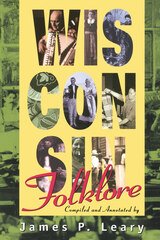 Wisconsin Folklore
Edited by James P. Leary
University of Wisconsin Press, 1999 Highly entertaining and richly informative, Wisconsin Folklore offers the first comprehensive collection of writings about the surprisingly varied folklore of Wisconsin. Beginning with a historical introduction to Wisconsin's folklore and concluding with an up-to-date bibliography, this anthology offers more than fifty annotated and illustrated entries in five sections: "Terms and Talk," "Storytelling," "Music, Song, and Dance," "Beliefs and Customs," and "Material Traditions and Folklife."
The various contributors, from 1884 to 1997, are anthropologists, ethnomusicologists, historians, journalists, museologists, ordinary citizens reminiscing, sociologists, students, writers of fiction, practitioners of folklore, and folklorists. Their interests cover an enormous range of topics: from Woodland Indian place names and German dialect expressions to Welsh nicknames and the jargon of apple-pickers, brewers, and farmers; from Ho-Chunk and Ojibwa mythological tricksters and Paul Bunyan legends to stories of Polish strongmen and Ole and Lena jokes; from Menominee dances and Norwegian fiddling and polka music to African-American gospel groups and Hmong musicians; from faith healers and wedding and funeral customs to seasonal ethnic festivities and tavern amusements; and from spearing decoys and needlework to church dinners, sacred shrines, and the traditional work practices of commercial fishers, tobacco growers, and pickle packers.
For general readers, teachers, librarians, and scholars alike, Wisconsin Folklore exemplifies and illuminates Wisconsin's cultural traditions, and establishes the state's significant but long neglected contributions to American folklore.
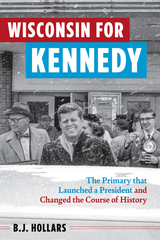 Wisconsin for Kennedy: The Primary That Launched a President and Changed the Course of History
B. J. Hollars
Wisconsin Historical Society Press, 2024 The behind-the-scenes story of JFK’s 1960 Wisconsin primary campaign When John F. Kennedy ran for president in 1960, he did something no candidate had done before: he leveraged the power of state primaries to win his party’s nomination. Kennedy’s first battleground state? Wisconsin—a state that would prove more arduous, more exhausting, and more crucial to winning the presidency than any other. Wisconsin for Kennedy brings to life the stories behind JFK’s history-making 1960 Wisconsin primary campaign, and how Kennedy’s team managed to outmaneuver his politically seasoned opponent, Hubert Humphrey. From Jackie Kennedy commandeering a supermarket loudspeaker in Kenosha, to the Wisconsin forklift driver who planned President Kennedy’s final trip to Dallas, this captivating book places readers at the heart of the action. Author B.J. Hollars chronicles JFK’s nail-biting Wisconsin win by drawing on rarely cited oral histories from the eclectic team of people who worked together to make it happen: a cranberry farmer, a union leader, a mayor, an architect, and others. Wisconsin for Kennedy explores how Wisconsin helped propel JFK all the way to the White House in a riveting historical account that reads like a work of rollicking, page-turning fiction. “In the spirit of Theodore H. White’s The Making of The President: 1960, B.J. Hollars offers a vivid account of the Wisconsin primary that launched JFK’s successful presidential campaign, inspiring voters to pass the torch to a new generation of leadership for our country. Anyone mesmerized by JFK’s legacy will enjoy this great read.” —Former US Representative Ron Kind
“For generations, my family has had the great privilege of serving the people of Wisconsin. In Wisconsin for Kennedy, B.J. Hollars performs his own act of service, recounting the riveting and untold story of Wisconsin’s politically perilous 1960 primary. A poignant contribution to political history that reads like a page-turner.”
—Former Wisconsin Governor James Doyle Jr.
"A hopeful quality . . . pervades Wisconsin for Kennedy, written about a time and place when politics was conducted in a less severe and divisive way than it is now. Hollars further succeeds in showing how political history is made by a wide range of citizens. Wisconsinites, Midwesterners, and indeed Americans of all political persuasions can be grateful to B.J. Hollars for these important reminders."
— Middle West Review
The Wisconsin Historical Society: Collecting, Preserving, and Sharing Stories Since 1846
John Zimm
Wisconsin Historical Society Press, 2014 Explore the storied history of this grand Wisconsin treasure – the Wisconsin Historical Society, older than the state itself. From the Society’s earliest days as pioneers worked to record history even as it was happening, to its struggles to weather the Great Depression, and its landmark efforts to record the most important social and political movements of our times. From its very start, the Society has worked to “treasure up” the stories of people from every walk of life, in every corner of the state. The story behind the Wisconsin Historical Society is a uniquely Wisconsin story – one that belongs to all who call Wisconsin home.
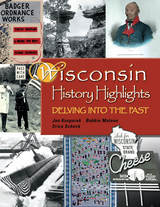 Wisconsin History Highlights: Delving into the Past
Jon Kasparek, Bobbie Malone, and Erica Schock
Wisconsin Historical Society Press, 2004 Wisconsin History Highlights encourages middle and high school students, including National History Day participants, to use Wisconsin topics and resources as they research American history. The book guides students on their way, drawing them in with the topics most likely to spur their curiosity and enthusiasm. Wisconsin History Highlights introduces students to essential skills for historical research, including locating primary and secondary materials, choosing and narrowing a topic, and avoiding plagiarism. The text includes nine chapters: Discovering the Past; Immigration; Agriculture; Industry; Environment; Social Issues; Government; Tourism; and Arts, Entertainment, and Sports. Each chapter has a variety of concise historical vignettes about specific events, people, or places in Wisconsin history, and within each vignette, students will find hints to get started with research on that or a related topic. The chapters contain many illustrations of sample source materials, and each closes with a detailed bibliography of available primary and secondary resources. Students will find ample guidance in many places, from the helpful introductory material, the table of contents, and the topical chapters to the thorough index, which together make Wisconsin History Highlights an essential tool for expanding students' conceptions of history and refining their research skills.
 Wisconsin Idols: 100 Heroes Who Changed the State, the World, and Me
Dean Robbins
Wisconsin Historical Society Press, 2025 Inspiring stories of celebrities and locals who made their presence known in Wisconsin
Discover intriguing true tales of legends and trailblazers with Wisconsin connections who left their mark on the world, including the Beatles, Georgia O’Keeffe, Kareem Abdul-Jabbar, Harrison Ford, Joni Mitchell, Abraham Lincoln, Oprah Winfrey, Bob Dylan, Jackie Robinson, Orson Welles, and many more. Marvel at Elvis Presley’s miracle on the streets of Madison, applaud the award-winning acting of Reedsburg’s Agnes Moorehead, follow fearless quarterback Bart Starr to the gates of hell in Green Bay, and join Joshua Glover in Racine on his daring escape from enslavers. These brief narratives—whether poignant or humorous—also offer personal reflections on the impact of each featured idol.
Author Dean Robbins has spent a lifetime researching and revering these prominent figures and visiting exhibits, shrines, historic homes, and other sites dedicated to their achievements. Wisconsin Idols gathers all of Robbins’s obsessions into one collection, enhanced by dozens of photographs. Taken together, these stories of musicians, activists, artists, athletes, actors, and great thinkers irrefutably establish Wisconsin as a crossroads for extraordinary people who changed the world.
Wisconsin in the Civil War: The Home Front and the Battle Front, 1861-1865
Frank Klement
Wisconsin Historical Society Press, 1997 The final book by Marquette University historian Frank L. Klement (1905-1994), this is a vivid chronological narrative of Wisconsin's role in the pivotal event in American history. In this volume, Klement greatly expanded his 1962 booklet on this topic, adding new material on each of Wisconsin's fifty-three infantry regiments, political and constitutional issues, soldiers voting, women and the war, and Wisconsin's black soldiers.
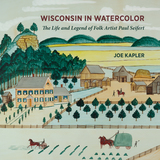 Wisconsin in Watercolor: The Life and Legend of Folk Artist Paul Seifert
Joe Kapler
Wisconsin Historical Society Press, 2018 In 1867, German immigrant Paul Seifert settled in the Driftless Area of southwestern Wisconsin and began capturing the distinctive farms and landscapes of his new home in vivid, detailed watercolors. Today, these paintings are coveted by American folk art collectors across the country, but Seifert’s life remains shrouded in mystery. In this first book written about Paul Seifert, author Joe Kapler examines the life of this enigmatic artist and provides context for his extraordinary art. The book features high-quality reproductions of twenty-two Seifert watercolors (more than half of which have never been published) and many close-ups of his characteristic details, from horses and hay wagons to dogs and dinner bells. Part art history treatment, part coffee table book, part research memoir, and part love letter to the Driftless Area, Wisconsin in Watercolor shines a long-awaited light on Seifert and the land he so carefully rendered over a hundred years ago.
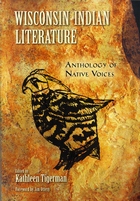 Wisconsin Indian Literature: Anthology of Native Voices
Edited by Kathleen Tigerman; Foreward by Jim Ottery
University of Wisconsin Press, 2006 Literature of the Indian Nations of Wisconsin is a unique anthology that presents the oral traditions, legends, speeches, myths, histories, literature, and historically significant documents of the current twelve independent bands and Indian Nations of Wisconsin. Kathleen Tigerman sought input from tribe elders and educators to provide an accurate chronological portrait of each nation, including the Siouan Ho-Chunk; the Algonquian Menominee, Ojibwe, and Potawatomi; and three groups originally from what is now New York State: the Iroquoian Oneida, the Stockbridge-Munsee band of the Mohican Nations, and the Brothertown Nation.
Some of these works feature a cultural hero or refer to very ancient times—more than six thousand years ago—and others are contemporary. These pieces focus on issues of Wisconsin Native communities by sharing Native knowledge and dialogue about sovereignty, decolonization, cultural genocide, forced removals, assimilation, and other concerns.
This anthology introduces us to a vivid and unforgettable group of voices, enhanced by many maps, photographs, and chronologies. Literature of the Indian Nations of Wisconsin fosters cross-cultural understanding among non-Native readers and the people of the First Nations.
Wisconsin Indians
Nancy Oestreich Lurie
Wisconsin Historical Society Press, 2002 This best-selling short history of Wisconsin's native peoples is now updated and expanded to include events through the end of the twentieth century. From the treaty-making era to the reawakening of tribal consciousness in the 1960s to the profound changes brought about by Indian gaming, Lurie’s classic account remains the best concise treatment of the subject.
Wisconsin Korean War Stories: Veterans Tell Their Stories from the Forgotten War
Sarah Larsen
Wisconsin Historical Society Press, 2008 A companion to the Wisconsin Public Television documentary of the same name, this compelling book features the stories of Wisconsin men and women who served in Korea. With unique insight they describe their experiences in camp, on the battlefield, and back home, as well as the war's lasting effects. The book is lavishly illustrated with photos, artifacts, maps, and timelines.
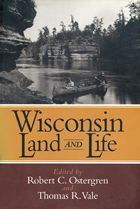 Wisconsin Land and Life: A Portrait of the State
Robert C. Ostergren
University of Wisconsin Press, 1997 Rolling green hills dotted with Holstein cows, red barns, and blue silos. The Great Lakes ports at Superior, Ashland, and Kenosha. A Polish wedding dance or a German biergarten in Milwaukee. The dappled quiet of the Chequamagon forest. A weatherbeaten but tidy town hall at the intersection of two county trunk highways. Ojibwa families gathering wild rice into canoes. The boat ride through the Dells. The upland ridges of the Driftless Area, falling away into hidden valleys. . . .
These are images of Wisconsin's land and life, images that evoke a strong sense of place. This book, Wisconsin Land and Life, is an exploration of place, a series of original essays by Wisconsin geographers that offers an introduction to the state's natural environment, the historical processes of its human habitation, and the ways that nature and people interact to create distinct regional landscapes. To read it is to come away with a sweeping view of Wisconsin's geography and history: the glaciers that carved lakes and moraines; the soils and climate that fostered the prairies and great northern pine forests; the early Native Americans who began to shape the landscape and who established forest trails and river portages; the successive waves of Europeans who came to trade in furs, mine for lead and iron, cut the white pines, establish farms, work in the lumber and paper mills, and transform spent wheatfields into pasture for dairy cattle.
Readers will learn, too, about the platting and naming of Wisconsin's towns, the establishment of county and township governments, the growth of urban neighborhoods and parishes, the role of rivers, railroads, and religion in shaping the state's growth, and the controversial reforestation of the cutover lands that eventually transformed hardscrabble farms and swamps into a sportsman's paradise.
Abundantly illustrated with photos and maps, this book will richly reward anyone who wishes to learn more about the land and life of the place we know as Wisconsin.
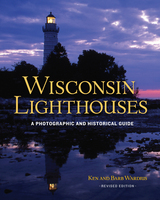 Wisconsin Lighthouses: A Photographic and Historical Guide, Revised Edition
Ken Wardius
Wisconsin Historical Society Press, 2013 “Lighthouses are a reflection of the human spirit and a mirror to our past.”—from the Introduction No symbol is more synonymous with Wisconsin’s rich maritime traditions than the lighthouse. These historic beacons conjure myriad notions of a bygone era: romance, loneliness, and dependability; dedicated keepers manning the lights; eerie tales of haunted structures and ghosts of past keepers; mariners of yesteryear anxiously hoping to make safe haven around rocky shorelines. If these sentinels could talk, imagine the tales they would tell of ferocious Great Lakes storms taking their toll on vessels and people alike.
In this fully updated edition of Wisconsin Lighthouses, Ken and Barb Wardius tell those tales, taking readers on an intimate tour of lighthouses on Lake Superior, Lake Michigan, and Lake Winnebago. Both delightful storytellers and accomplished photographers, the couple complement their engaging text with more than 100 stunning color photographs, along with dozens of archival photos, maps, documents, and artifacts. Detailed “how to get there” directions, up-to-the-minute status reports on each light, and sidebars on everything from lighthouse vocabulary to the often lonely lives of lightkeepers make this the definitive book on Wisconsin’s lighthouses.
Wisconsin My Home
Thurine Oleson; As told to her daughter Erna Oleson Xan; Introduction by Odd Lovoll
University of Wisconsin Press, 2012 Wisconsin My Home is the story of Thurine Oleson, born in Wisconsin in 1866 to parents who had emigrated from Telemarken, Norway. This much-loved book was first published in 1950 when Thurine was a spry octogenarian. In it she not only vividly recalls the pioneer life of her childhood in a Norwegian American settlement, but also tells her parents’ stories of their life in Norway and their reasons for emigration. This new edition restores the twenty-nine photographs that appeared in the original 1950 hardcover edition and includes an introduction by emigration historian Odd Lovoll.
Wisconsin, My Home: The Story of Thurine Oleson as Told to Her Daughter
Erna Oleson Xan
University of Wisconsin Press, 1975 Wisconsin My Home is the story of Thurine Oleson, born in Wisconsin in 1866 to parents who had emigrated from Telemarken, Norway. This much-loved book was first published in 1950 when Thurine was a spry octogenarian. In it she not only vividly recalls the pioneer life of her childhood in a Norwegian American settlement but also tells her parents’ stories of their life in Norway and their reasons for emigration. This new edition restores the twenty-nine photographs that appeared in the original 1950 hardcover edition and includes an introduction by emigration historian Odd Lovell.
 Wisconsin on the Air: 100 Years of Public Broadcasting in the State That Invented It
Jack Mitchell
Wisconsin Historical Society Press, 2016 On a wintry evening in 1917, university professor Earle Terry listened with guests as the popular music of the day filtered from a physics laboratory in Science Hall into a receiving set in his living room. Little did they know that one hundred years of public service broadcasting had just begun. Terry’s radio experiment blossomed into a pioneering endeavor to carry out the "Wisconsin Idea," a promise to make the university’s knowledge accessible to all Wisconsinites, in their homes, statewide, a Progressive-era principle that still guides public broadcasting in Wisconsin and throughout the nation. In 1947, television was added to this public service model with Channel 21 in Madison, produced, like radio, from the University of Wisconsin campus. By 1967, when the Public Broadcasting Act created the Public Broadcasting System (PBS) and National Public Radio (NPR), the Wisconsin stations had been broadcasting for fifty years. A history one hundred years in the making, Wisconsin on the Air introduces readers to the personalities and philosophies, the funding challenges and legislation, the original Wisconsin programming and pioneering technology that gave us public radio and television. Author Jack Mitchell, who developed All Things Considered for NPR before becoming the head of Wisconsin Public Radio, deftly maps public broadcasting’s hundred-year journey by charting Wisconsin’s transition from the early days of radio and television to educational broadcasting to the news, information, and music of Wisconsin Public Radio and Wisconsin Public Television.
Wisconsin: Our State CLASSROOM SET 1E spanish (w/eng SAG)
Bobbie Malone
Wisconsin Historical Society Press
"Wisconsin: Our State, Our Story" brings history to life! Thinking Like a Historian questions in each chapter encourage critical thinking. Scores of artifacts and documents invite students to become eyewitnesses to the past.
Lively, classroom-tested text will engross students. The rich content aligns with relevant, cross-curricular Wisconsin Model Academic Standards. The specially designed Teacher's Edition and Student Activity Guide provide additional tools to reach all learners.
Wisconsin: Our State CLASSROOM SET 1E spanish (w/spnsh SAG)
Bobbie Malone
Wisconsin Historical Society Press, 2016
Classroom set includes 25 copies of the Spanish textbook (978-0-87020-512-5) PLUS 1 copy of the Teacher's Edition in English (978-0-87020-379-4) and 1 copy of the Student Activity Guide DVD in Spanish (978-0-87020-688-7)
Wisconsin: Our State CLASSROOM SET 2E spanish
Bobbie Malone
Wisconsin Historical Society Press "Wisconsin: Our State, Our Story" brings history to life! Thinking Like a Historian questions in each chapter encourage critical thinking. Scores of artifacts and documents invite students to become eyewitnesses to the past. Lively, classroom-tested text will engross students. The rich content aligns with relevant, cross-curricular Wisconsin Model Academic Standards. The specially designed Teacher's Edition and Student Activity Guide provide additional tools to reach all learners.
Classroom set includes:
25 Student Textbooks,
1 Teacher’s Edition, and
1 Student Activity Guide disc
Wisconsin: Our State SAG 1E CD spanish
Bobbie Malone
Wisconsin Historical Society Press, 2014
"Wisconsin: Our State, Our Story" brings history to life! Thinking Like a Historian questions in each chapter encourage critical thinking. Scores of artifacts and documents invite students to become eyewitnesses to the past.
Lively, classroom-tested text will engross students. The rich content aligns with relevant, cross-curricular Wisconsin Model Academic Standards. The specially designed Teacher's Edition and Student Activity Guide provide additional tools to reach all learners.
Wisconsin: Our State SAG 1E eng: Student Activity Guide
Bobbie Malone
Wisconsin Historical Society Press, 2008 Join thousands of students across Wisconsin as they experience our history through the primary sources created by the people who lived it. From human-created artifacts over 14,000 years old to the impact of 9/11, Wisconsin: Our State, Our Story will breathe life into your elementary social studies curriculum.
Wisconsin: Our State SAG 2E CD spanish
Bobbie Malone
Wisconsin Historical Society Press, 2017 "Wisconsin: Our State, Our Story" brings history to life! Thinking Like a Historian questions in each chapter encourage critical thinking. Scores of artifacts and documents invite students to become eyewitnesses to the past. Lively, classroom-tested text will engross students. The rich content aligns with relevant, cross-curricular Wisconsin Model Academic Standards. The specially designed Teacher's Edition and Student Activity Guide provide additional tools to reach all learners.
Wisconsin: Our State SAG 2E eng
Bobbie Malone
Wisconsin Historical Society Press, 2016
"Wisconsin: Our State, Our Story" brings history to life! Thinking Like a Historian questions in each chapter encourage critical thinking. Scores of artifacts and documents invite students to become eyewitnesses to the past.
Lively, classroom-tested text will engross students. The rich content aligns with relevant, cross-curricular Wisconsin Model Academic Standards. The specially designed Teacher's Edition and Student Activity Guide provide additional tools to reach all learners.
Wisconsin: Our State SAG 2E eng DIGITAL
Bobbie Malone
Wisconsin Historical Society Press, 2016 "Wisconsin: Our State, Our Story" brings history to life! Thinking Like a Historian questions in each chapter encourage critical thinking. Scores of artifacts and documents invite students to become eyewitnesses to the past. Lively, classroom-tested text will engross students. The rich content aligns with relevant, cross-curricular Wisconsin Model Academic Standards. The specially designed Teacher's Edition and Student Activity Guide provide additional tools to reach all learners.
Wisconsin: Our State TE 1E
Bobbie Malone
Wisconsin Historical Society Press, 2008 The Teacher's Edition provides educators with the background, literacy, and other skill-building strategies to teach "Wisconsin: Our State, Our Story" in both social studies and literacy classes.
"Wisconsin: Our State, Our Story" textbook promotes content-focused reading to address both social studies and language arts standards for the state of Wisconsin.
The Teacher's Edition draws on the research-based pedagogy in both literacy developmnent and in historical inquiry to help reach the many different levels of learners in today's classrooms.
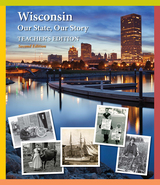 Wisconsin: Our State TE 2E
Bobbie Malone
Wisconsin Historical Society Press, 2016 The Teacher's Edition provides educators with the background, literacy, and other skill-building strategies to teach "Wisconsin: Our State, Our Story" in both social studies and literacy classes. "Wisconsin: Our State, Our Story" textbook promotes content-focused reading to address both social studies and language arts standards for the state of Wisconsin. The Teacher's Edition draws on the research-based pedagogy in both literacy development and in historical inquiry to help reach the many different levels of learners in today's classrooms.
Features of the Teacher's Edition - Differentiated Learning Approaches The Teacher's Edition draws together and charts a compendium of literacy strategies, historical thinking skills, and differentiated learning approaches in the introductory section.
- Supports Both Literacy and History Learning Each of the early chapters focuses on a different literacy skill. Students have the opportunity to practice and master each skill as they progress through the textbook. Though each chapter differs in length, they all have the same components, so that students can learn to make connections. Major, overarching questions drive the content of each chapter.
- An Inquiry-Based History Approach Each topic is inquiry-based. Students quickly learn that the historian plays the role of detective: asking questions and amassing enough clues to put together a "picture" of some historical event or personality and to weave these into a sufficiently broad understanding.
Wisconsin: Our State TEXTBOOK 1E eng: Student textbook
Bobbie Malone
Wisconsin Historical Society Press, 2008
"Wisconsin: Our State, Our Story" brings history to life! Thinking Like a Historian questions in each chapter encourage critical thinking. Scores of artifacts and documents invite students to become eyewitnesses to the past.
Lively, classroom-tested text will engross students. The rich content aligns with relevant, cross-curricular Wisconsin Model Academic Standards. The specially designed Teacher's Edition and Student Activity Guide provide additional tools to reach all learners.
Wisconsin: Our State TEXTBOOK 1E spanish
Bobbie Malone
Wisconsin Historical Society Press, 2012
"Wisconsin: Our State, Our Story" brings history to life! Thinking Like a Historian questions in each chapter encourage critical thinking. Scores of artifacts and documents invite students to become eyewitnesses to the past.
Lively, classroom-tested text will engross students. The rich content aligns with relevant, cross-curricular Wisconsin Model Academic Standards. The specially designed Teacher's Edition and Student Activity Guide provide additional tools to reach all learners.
Wisconsin: Our State TEXTBOOK 2E eng
Bobbie Malone
Wisconsin Historical Society Press, 2016 "Wisconsin: Our State, Our Story" brings history to life! Thinking Like a Historian questions in each chapter encourage critical thinking. Scores of artifacts and documents invite students to become eyewitnesses to the past. Lively, classroom-tested text will engross students. The rich content aligns with relevant, cross-curricular Wisconsin Model Academic Standards. The specially designed Teacher's Edition and Student Activity Guide provide additional tools to reach all learners.
Wisconsin: Our State TEXTBOOK 2E spanish
Bobbie Malone
Wisconsin Historical Society Press, 2017 "Wisconsin: Our State, Our Story" brings history to life! Thinking Like a Historian questions in each chapter encourage critical thinking. Scores of artifacts and documents invite students to become eyewitnesses to the past. Lively, classroom-tested text will engross students. The rich content aligns with relevant, cross-curricular Wisconsin Model Academic Standards. The specially designed Teacher's Edition and Student Activity Guide provide additional tools to reach all learners.
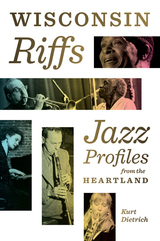 Wisconsin Riffs: Jazz Profiles from the Heartland
Kurt Dietrich
Wisconsin Historical Society Press, 2018 An extensive, upbeat compilation of Wisconsin’s jazz musicians
Although New York City, Los Angeles, and Chicago are often considered the epicenters of American jazz, this extensive, upbeat compilation of jazz musician biographies details Wisconsin’s rich association the genre since its the inception of the genre in the early 1900s. Iconic musicians Bunny Berigan, Woody Herman, Les Paul, and Al Jarreau all hailed from Wisconsin, as have many other influential players, composers, and teachers. Wisconsin Riffs features these musicians side-by-side—from the world-renowned to obscure regional artists—to portray a comprehensive history of jazz in Wisconsin.
Through meticulous research and more than a hundred interviews, author Kurt Dietrich has assembled a group of musicians who represent a wide range of backgrounds, ages, stylistic schools, and experiences—from leaders of swing-era big bands to legendary Wisconsin Conservatory instructors to today’s up-and-coming practitioners of contemporary jazz and jazz rock. For aspiring musicians, jazz enthusiasts, and fans of Wisconsin culture alike, Wisconsin Riffs presents a compelling, complex, and multi-layered concoction—just like jazz itself.
The Wisconsin: River of a Thousand Isles
August Derleth
University of Wisconsin Press, 1985 A classic account of the Wisconsin River's early exploration by French traders and Jesuit priests through the 1940s. Mixing folklore and legend, Derleth tells of the Winnebago, Sauk, and Fox peoples; of lumberjacks, farmers, miners, and preachers; of ordinary folks and famous figures such as the Ringling Brothers, Chief Blackhawk, Frank Lloyd Wright, and Zona Gale.
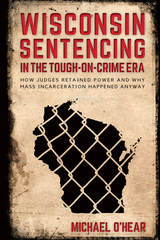 Wisconsin Sentencing in the Tough-on-Crime Era: How Judges Retained Power and Why Mass Incarceration Happened Anyway
Michael O'Hear
University of Wisconsin Press, 2021 The dramatic increase in U.S. prison populations since the 1970s is often blamed on the mandatory sentencing required by "three strikes" laws and other punitive crime bills. Michael O'Hear shows that the blame is actually not so easily assigned. His meticulous analysis of incarceration in Wisconsin—a state where judges have considerable discretion in sentencing—explores the reasons why the prison population has ballooned nearly tenfold over the past forty years.
O'Hear tracks the effects of sentencing laws and politics in Wisconsin from the eve of the imprisonment boom in 1970 up to the 2010s. Drawing on archival research, original public-opinion polling, and interviews with dozens of key policymakers, he reveals important dimensions that have been missed by others. He draws out lessons from the Wisconsin experience for the United States as a whole, where mass incarceration has cost taxpayers billions of dollars and caused untold misery to millions of inmates and their families.
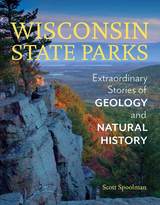 Wisconsin State Parks: Extraordinary Stories of Geology and Natural History
Scott Spoolman
Wisconsin Historical Society Press, 2018 Hit the trail for a dramatic look at Wisconsin’s geologic past.
The impressive bluffs, valleys, waterfalls, and lakes of Wisconsin’s state parks provide more than beautiful scenery and recreational opportunities. They are windows into the distant past, offering clues to the dramatic events that have shaped the land over billions of years.
Author and former DNR journalist Scott Spoolman takes readers with him to twenty-eight parks, forests, and natural areas where evidence of the state’s striking geologic and natural history are on display. In an accessible storytelling style, Spoolman sheds light on the volcanoes that poured deep layers of lava rock over a vast area in the northwest, the glacial masses that flattened and molded the landscape of northern and eastern Wisconsin, mountain ranges that rose up and wore away over hundreds of millions of years, and many other bedrock-shaping phenomena. These stories connect geologic processes to the current landscape, as well as to the evolution of flora and fauna and development of human settlement and activities, for a deeper understanding of our state’s natural history.
The book includes a selection of detailed trail guides for each park, which hikers can take with them on the trail to view evidence of Wisconsin’s geologic and natural history for themselves.
The Wisconsin Story: 150 People, Places, and Turning Points that Shaped the Badger State
Dennis McCann
Wisconsin Historical Society Press, 2019 The Wisconsin Story: 150 People, Places, and Turning Points that Shaped the Badger State offers readers engaging vignettes about everything Wisconsin. From portraits of significant figures like Robert and Belle La Follette, Golda Meir, and Edna Ferber, to stories of important events like the Black Hawk War, 1960s campus protests, and oleo smuggling, The Wisconsin Story takes readers on a fun and informative ride all across the Badger State. Where was Calvin Coolidge’s summer White House? What was the “anti-corset resolution?” And why was a cow named Ollie milked on an airplane? Award-winning newspaper columnist Dennis McCann’s talent for distilling complex subjects into brief stories that pack a punch makes this collection the perfect answer to the question “what makes Wisconsin, Wisconsin?”
 Wisconsin Talk: Linguistic Diversity in the Badger State
Edited by Thomas Purnell, Eric Raimy, and Joseph Salmons
University of Wisconsin Press, 2013 Wisconsin is one of the most linguistically rich places in North America. It has the greatest diversity of American Indian languages east of the Mississippi, including Ojibwe and Menominee from the Algonquian language family, Ho-Chunk from the Siouan family, and Oneida from the Iroquoian family. French place names dot the state's map. German, Norwegian, and Polish—the languages of immigrants in the nineteenth and early twentieth centuries—are still spoken by tens of thousands of people, and the influx of new immigrants speaking Spanish, Hmong, and Somali continues to enrich the state's cultural landscape. These languages and others (Walloon, Cornish, Finnish, Czech, and more) have shaped the kinds of English spoken around the state. Within Wisconsin's borders are found three different major dialects of American English, and despite the influences of mass media and popular culture, they are not merging—they are dramatically diverging.
An engaging survey for both general readers and language scholars, Wisconsin Talk brings together perspectives from linguistics, history, cultural studies, and geography to illuminate why language matters in our everyday lives. The authors highlight such topics as:
• words distinctive to the state
• how recent and earlier immigrants have negotiated cultural and linguistic challenges
• the diversity of bilingual speakers that enriches our communities
• how maps can convey the stories of language
• the relation of Wisconsin's Indian languages to language loss worldwide.
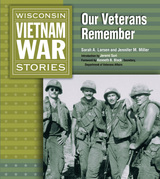 Wisconsin Vietnam War Stories: Our Veterans Remember
Sarah Larsen
Wisconsin Historical Society Press, 2010 A companion book to the documentary produced by Wisconsin Public Television, Wisconsin Vietnam War Stories showcases 40 first-person stories from those who fought in America's longest war. From barely-legal sons of Wisconsin to seasoned soldiers, the men and women in these pages make up a diverse collection of voices: an army chaplain who led services at Khe Sanh but never picked up a weapon; identical twin brothers who discover they are stationed at the same South Vietnam base; a Hmong refugee who fought the Secret War at age 12 in the jungles of Laos and later moved to Milwaukee; two prisoners of war whose years in captivity total almost 14; a Medal of Honor recipient; and dozens more. The stories in these pages expand beyond the borders of the war to include personal accounts of the events leading up to it, as well as the experiences of veterans as they return home to civilian life at the height of antiwar protest. Supported by original maps, photographs from the veterans' own collections, historical chapter introductions, biographies, and a comprehensive "honor roll" of Wisconsin-born soldiers who died or remain missing, Wisconsin Vietnam War Stories is an unforgettable collection and lasting tribute to our veterans.
Wisconsin Votes: An Electoral History
Robert Booth Fowler
University of Wisconsin Press, 2008 This is the first full history of voting in Wisconsin from statehood in 1848 to the present. Fowler both tells the story of voting in key elections across the years and investigates electoral trends and patterns over the course of Wisconsin’s history. He explores the ways that ethnic and religious groups in the state have voted historically and how they vote today, and he looks at the successes and failures of the two major parties over the years. Highlighting important historical movements, Fowler discusses the great struggle for women’s suffrage and the rich tales of many Wisconsin third parties—the Socialists, Progressives, the Prohibition Party, and others. Here, too, are the famous politicians in Wisconsin history, such as the La Follettes, William Proxmire, and Tommy Thompson. Winner, Award of Merit for Leadership in History, American Association for State and Local History
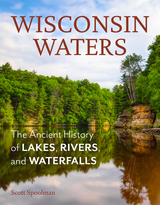 Wisconsin Waters: The Ancient History of Lakes, Rivers, and Waterfalls
Scott Spoolman
Wisconsin Historical Society Press, 2022 Every Wisconsin waterway has a story, from the Great Lakes and the Mighty Mississippi to thousands of interior lakes, rivers, and trout streams. Wisconsin Waters takes readers on an epic tour of the geologic, natural, and human stories that have shaped these aquatic landscapes over millions of years. In this companion to his popular Wisconsin State Parks book, Scott Spoolman journeys to the distant past to examine the origins of Wisconsin’s lakes, rivers, waterfalls, and wetlands. In his accessible storytelling style, Spoolman details the natural forces—volcanic eruptions, ancient seas, erosion, glaciers, and more—that created these bodies of water and the resulting habitats for the state’s flora, fauna, and early peoples. More than a geology or natural history book, Wisconsin Waters invites readers to visit waterways in four regions of the state, where they can view the modern-day evidence of how they were formed. Nineteen travel guides suggest ways to explore a selection of Wisconsin waterscapes, providing a better understanding of the land’s history that will enhance readers’ enjoyment of and appreciation for our freshwater resources.
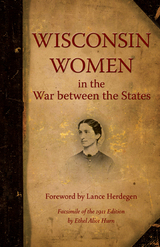 Wisconsin Women in the War between the States
Ethel Hurn
Wisconsin Historical Society Press, 2013 “There was too much to be done by the most of us, to keep the wolf from the door, to give way to our feelings, and it was better so. It gave us the feeling that we, too, although not enlisted in the ranks South, had a battle to fight at home on more than one line, and the worst of all was to keep up hope against hope, that our loved ones would be spared to come back to us…” As the fiftieth anniversary of the American Civil War neared, the Wisconsin History Commission was established to develop and publish a series of “original papers” on Wisconsin’s role in what was officially called the War of Rebellion. Picked as the sixth selection and published in May 1911 was Wisconsin Women in the War between the States by Ethel Alice Hurn. In many ways it was a landmark effort. It was one of the first formal recognitions—not only in Wisconsin but nationally—of the overlooked and almost forgotten role Northern women played in 1861–1865. The author of the study was Ethel Hurn of Oshkosh, then a student at the University of Wisconsin. Gathering the material for the book proved a daunting task. During the Civil War era women could not vote, hold bank accounts, or take a direct role in business. Nevertheless, in the time of national crisis, women took over farms and shops and other endeavors, and some left quiet family hearths to move onto the public stage. They prepared food, sewed and laundered, knitted socks and gloves, and organized campaigns and fairs as relief efforts that raised millions of dollars to aid wounded soldiers and assist war widows and orphans. However, these women’s work was generally undertaken without thought of keeping a formal record. It could be found only in scattered collections of letters, newspaper files, several interviews, and the brief reports and pamphlets of soldier fairs and soldiers’ aid societies. Wisconsin Women in the War between the States is just as significant today as it was a century ago because it documented an important turning point in the changing role of women in American society. Other scholars have added to the record in the passing years, but Hurn’s groundbreaking book is welcomed back in print during this 150th anniversary of the American Civil War to be discovered and enjoyed as well as to enlighten a new generation of readers.
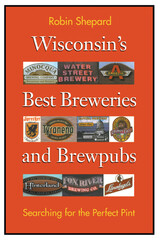 Wisconsin's Best Breweries and Brewpubs: Searching for the Perfect Pint
Robin Shepard
University of Wisconsin Press, 2001 This information-packed guidebook introduces you to more than sixty breweries and brewpubs—from the Shipwrecked Brew Pub in Egg Harbor, to smaller craft breweries like Capital Brewery west of Madison, to the world-famous Miller Brewing Company of Milwaukee. Robin Shepard includes descriptions and his personal ratings of some 600 local beers, plus a taster’s chart you can use to record your own preferences. For each brewpub and brewery site you’ll find:
• a description and brief history, plus any "Don’t miss" features
• names, comments, and ratings for all their specialty beers
• notes on the pub food, with recommendations
• suggestions of other sites to see and activities in the local area
• information about bottling and distribution
• availability of tours, tastings, gift shops, mug clubs, and "growlers"
• address and contact data, including Web sites and GPS coordinates! Shepard also introduces novices to the brewing process and a wide variety of beer styles. And, you’ll find a list of helpful books and Web sites, as well as information on Wisconsin beer tastings and festivals. As we say in Wisconsin, "So, have a couple a two, three beers, hey?"
Wisconsin's Foundations: A Review of the State's Geology and Its Influence on Geography and Human Activity
Gwen Schultz
University of Wisconsin Press, 2004 Most people in Wisconsin share a deep appreciation of the shape and composition of their familiar landscapes—the abundance of fresh water, the fertile soils, the northern forests, the varied landforms. All these features relate to a process that is long, complex, and still in progress. Wisconsin’s Foundations is just the book for a broad audience of people who want to know more about the origins, evolution, and geological underpinnings of the Wisconsin landscape.
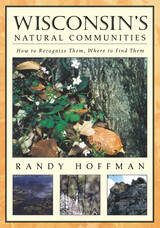 Wisconsin's Natural Communities: How to Recognize Them, Where to Find Them
Randy Hoffman
University of Wisconsin Press, 2002 Cattails grow in a marsh, pitcher plants grow in a bog, jewelweed grows in a swamp, right? Do sandhill cranes live among sandy hills? Frogs live near lakes and ponds, but can they live on prairies, too? What is a pine barrens, an oak opening, a calcareous fen?
Wisconsin’s Natural Communities is an invitation to discover, explore, and understand Wisconsin’s richly varied natural environment, from your backyard or neighborhood park to stunning public preserves.Part 1 of the book explains thirty-three distinct types of natural communities in Wisconsin—their characteristic trees, beetles, fish, lichens, butterflies, reptiles, mammals, wildflowers—and the effects of geology, climate, and historical events on these habitats. Part 2 describes and maps fifty natural areas on public lands that are outstanding examples of these many different natural communities: Crex Meadows, Horicon Marsh, Black River Forest, Maribel Caves, Whitefish Dunes, the Blue Hills, Avoca Prairie, the Moquah Barrens and Chequamegon Bay, the Ridges Sanctuary, Cadiz Springs, Devil’s Lake, and many others.
Intended for anyone who has a love for the natural world, this book is also an excellent introduction for students. And, it provides landowners, public officials, and other stewards of our environment with the knowledge to recognize natural communities and manage them for future generations.
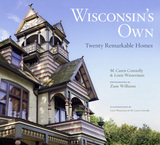 Wisconsin’s Own: Twenty Remarkable Homes
M. Caren Connolly
Wisconsin Historical Society Press, 2010 Take an intimate journey through the family, history, and architecture of 20 residential treasures in Wisconsin’s Own by M. Caren Connolly and Louis Wasserman. Richly illustrated with the photography of Zane Williams and complemented by historical images and watercolors and line drawings, Wisconsin’s Own profiles the architectural history of state’s most remarkable residences built between 1854 and 1939. The houses are a mix of public and private homes that are representative of varied architectural styles, from an Italianate along the Mississippi River and an interpretation of a sixteenth-century northern Italian villa overlooking Lake Michigan to an Adirondack-style camp in the North Woods and a fourteen-bedroom Georgian Revival mansion on Lake Geneva. Frank Lloyd Wright’s Prairie School is, of course, represented as well with examples by Wright and his mentor Louis Sullivan.
Wisconsin’s Own tells the story of the considerable contribution that each of these historic homes have made to American residential architecture. It also answers the questions who built the house, what brought them to Wisconsin, why they selected that particular style, and how it is that this historic home still stands—and shines—today.
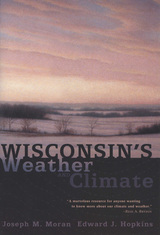 Wisconsin's Weather and Climate
Joseph M. Moran
University of Wisconsin Press, 2003 The land that is now called Wisconsin has a place in weather history. Its climate has ranged from tropical to polar over hundreds of millions of years—and even today, that’s the seeming difference between July and January here. And Wisconsinites have played key roles in advancing the science of meterology and climatology: Increase Lapham helped found the National Weather Service in the nineteenth century; Eric Miller was the first to broadcast regular weather reports on the radio in the 1920s; Verner Suomi pioneered tracking weather by satellite; and Reid Bryson has been a leader in studying global climate change.
Wisconsin's Weather and Climate is written for weather buffs, teachers, students, outdoor enthusiasts, and those working in fields, lakes, and forests for whom the weather is a daily force to be reckoned with. It examines the physical features of Wisconsin that shape the state’s climate—topography, mid-latitude location, and proximity to Lakes Superior and Michigan—and meteorological phenomena that affect climate, such as atmospheric circulation and air mass frequency. Authors Joseph M. Moran and Edward J. Hopkins trace the evolution of methods of weather observation and forecasting that are so important for agriculture and Great Lakes commerce, and they explain how Wisconsin scientists use weather balloons, radar, and satellites to improve forecasting and track climate changes. They take readers through the seasonal changes in weather in Wisconsin and give an overview of what past climate changes might tell us about the future.
Appendices provide climatic data for Wisconsin, including extremes of temperature, snowfall, and precipitation at selected stations in the state. The authors also list sources for further information.
Vignettes throughout the book provide fascinating weather lore:
o Why there are cacti in Wisconsin
o The famous Green Bay Packers–Dallas Cowboys "Ice Bowl" game of 1967
o The Army Signal Corps’ ban on the word tornado
o Advances in snow-making technology
o The decline of the Great Lakes ice industry
Wisdom from the Late Bronze Age
Yoram Cohen
SBL Press, 2013 This volume presents the original texts and annotated translations of a collection of Mesopotamian wisdom compositions and related texts of the Late Bronze Age (ca. 1500–1200 B.C.E.) found at the ancient Near Eastern sites of Hattuša, Emar, and Ugarit. These wisdom compositions constitute the missing link between the great Sumerian wisdom corpus and early Akkadian wisdom literature of the Old Babylonian period, on the one hand, and the wisdom compositions of the first millennium B.C.E., on the other. Included here are works such as the Ballad of Early Rulers, Hear the Advice, and The Date-Palm and the Tamarisk, as well as proverb collections from Ugarit and Hattuša. A detailed introduction provides an assessment of the place of wisdom literature in the ancient curriculum and library collections.
Wisdom From World Religions: Pathways Toward Heaven On Earth
John Marks Templeton
Templeton Press, 2002 Every religion acknowledges certain spiritual principles and records them in its sacred literature and traditions. This book curates these ancient teachings and shows how they apply to modern life with the help of parables, quotations, and commentaries. By reading Wisdom from World Religions, people from all walks of life will be inspired to pursue their own spiritual growth and to contemplate questions central to our existence, such as how, through love and creativity, can we be agents of divinity on earth? Uplifting and instructional, this is a book to be treasured, studied, and practiced.
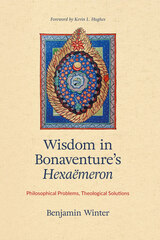 Wisdom in Bonaventure's Hexameron: Philosophical Problems, Theological Solutions
Benjamin Winter
Catholic University of America Press, 2024 This book presents Saint Bonaventure as a cutting-edge thinker who engaged with natural philosophy on its own terms. His final academic project was an unfinished collection of scholastic sermons titled Collationes in Hexaëmeron. At this moment in history, academics were clashing over the limits of cognition and the definition of science (scientia). Much has been written detailing how the incorporation of Aristotle’s philosophy into university curricula eventually prompted the Condemnations of 1270 and 1277. But perhaps it is incorrect to conceive of these events in a frame of escalating tensions leading to collapse. Perhaps a new perspective can be found by venturing back to 1273, to see Aristotle through the eyes of a theologian who was both magister and minister, bishop and brother—one who respected the academy’s rigor but also challenged its tendency toward self-absorption.
Guiding readers through vision one of Collationes in Hexaëmeron, Benjamin Winter argues that Bonaventure’s rejection of certain philosophical errors ought to be understood within the context of the virtuous person’s journey to wisdom. Propositions such as the eternity of the world, the unicity of the intellect, and fated necessity are not variables in a zero-sum equation “balanced out” by truths of faith. Instead, Bonaventure sees these propositions as opportunities to reflect charitably on nature and grace, emphasizing that just as knowledge is empty without love, understanding is insufficient without humility. Rather than renounce Aristotle or stifle scientific inquiry, Collationes in Hexaëmeron wholeheartedly acknowledges the affective and communal dimensions of philosophical knowledge. Bonaventure creates a magnificent and enduring text with powerful applications today.
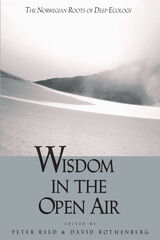 Wisdom In The Open Air: The Norwegian Roots of Deep Ecology
Peter Reed
University of Minnesota Press, 1992 Wisdom in the Open Air traces the Norwegian roots of the strain of thinking called “deep ecology”—the search for the solutions to environmental problems by examining the fundamental tenets of our culture. Although Arne Naess coined the term in the 1970s, the insights of deep ecology actually reflect a tradition of thought that can be seen in the history of Norwegian culture, from ancient mountain myths to the radical ecoactivism of today. Beginning with an introduction to Norway’s emphasis on nature and the wild, Reed and Rothenberg explore the birth of the environmental movement in the 1960s and 1970s. What follows is a collection of writings by prominent Norwegian thinkers on humanity and nature, most never before published in English. From Peter Wessel Zapffe, a twentieth-century Kierkegaardian figure, the list goes on to include Norwegian philosopher Arne Naess, activist-critic-artist Sigmund Kvaloy, wilderness educator Nils Faarland, novelist Finn Alneas, sociologist Johan Galtung, and social reformer Erik Dammann. Their fascinating points of view offer thoughts on the significance of modern life and what it means to be human in the face of the deteriorating global environment of the twentieth century. Wisdom in the Open Air asks and answers a fundamental question concerning the ecomovement: what is the role of deep, often abstract, thinking in the attempt to avert a very real ecological crisis?
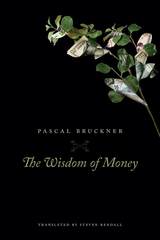 The Wisdom of Money
Pascal Bruckner
Harvard University Press, 2017 Money is an evil that does good, and a good that does evil. It inspires hymns to the prosperity it enables, manifestos about the poor it leaves behind, and diatribes for its corrosion of morality. In The Wisdom of Money, one of the world’s great essayists guides us through the rich commentary that money has generated since ancient times—both the passions and the resentments—as he builds an unfashionable defense of the worldly wisdom of the bourgeoisie.
Bruckner begins with the worshippers and the despisers. Sometimes they are the same people—priests, for example, who venerate the poor from within churches of opulence and splendor. This hypocrisy endures in our secular world, he says, not least in his own France, where it is de rigueur even among the rich to feign indifference to money. It is better to speak plainly about money in the old American fashion, in Bruckner’s view. A little more honesty would allow us to see through the myths of money’s omnipotence but also the dangers of the aristocratic, ideological, and religious systems of thought that try to put money in its place. This does not mean we should emulate the mega-rich with their pathologies of consumption, competition, and narcissistic philanthropy. But we could do worse than defy three hundred years of derision from novelists and poets to embrace the unromantic bourgeois virtues of work, security, and moderate comfort. It is wise to have money, Bruckner tells us, and wise to think about it critically.
 The Wisdom of Religious Commitment
Terrence W. Tilley
Georgetown University Press By exploring a practical, rather than propositional, understanding of religious belief, this book provides a new construct through which to view philosophy of religion. Terrence W. Tilley shifts the focus of debate from the justification of rational belief to the exercise of wisdom in making or maintaining a commitment to religious practices. It is through practices, Tilley concludes, that religious belief is formed. After analyzing the strengths and limitations of the modern approaches, Tilley applies the concept of wisdom to the process of making a religious commitment. Wisdom, as explored by Aristotle, St. Thomas Aquinas, and John Henry Newman, may be thought of as the bridge between intellectual and moral virtues. Roughly, it can be described as the ability to put intellect into action in a context. Because wisdom is a virtue requiring concrete display, the book discusses the wisdom of commitment to specific religious practices of a range of traditions. These examples demonstrate the issues and complexities involved in the wisdom of making a religious commitment. This important challenge to contemporary philosophy of religion will be of special interest to students and teachers of theology and philosophy of religion.
The Wisdom of the Ego
George E. Vaillant
Harvard University Press, 1998 One of America's preeminent psychiatrists draws on his famous Study of Adult Development to give us an exhilarating look at how the mind's defenses work. What we see as the mind's trickery, George Vaillant tells us, is actually healthy. What's more, it can reveal the mind at its most creative and mature, soothing and protecting us in the face of unbearable reality, managing the unmanageable, ordering disorder. And because creativity is so intrinsic to this alchemy of the ego, Vaillant mingles his studies of obscure lives with psychobiographies of famous artists and others--including Florence Nightingale, Sylvia Plath, Anna Freud, and Eugene O'Neill.
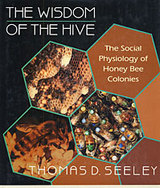 The Wisdom of the Hive: The Social Physiology of Honey Bee Colonies
Thomas D. Seeley
Harvard University Press, 1995 This book is about the inner workings of one of nature’s most complex animal societies: the honey bee colony. It describes and illustrates the results of more than fifteen years of elegant experimental studies conducted by the author. In his investigations, Thomas Seeley has sought the answer to the question of how a colony of bees is organized to gather its resources. The results of his research—including studies of the shaking signal, tremble dance, and waggle dance, and other, more subtle means by which information is exchanged among bees—offer the clearest, most detailed picture available of how a highly integrated animal society works. By showing how several thousand bees function together as an integrated whole to collect the nectar, pollen, and water that sustain the life of the hive, Seeley sheds light on one of the central puzzles of biology: how units at one level of organization can work together to form a higher-level entity.
In explaining why a hive is organized the way it is, Seeley draws on the literature of molecular biology, cell biology, animal and human sociology, economics, and operations research. He compares the honey bee colony to other functionally organized groups: multicellular organisms, colonies of marine invertebrates, and human societies. All highly cooperative groups share basic problems: of allocating their members among tasks so that more urgent needs are met before less urgent ones, and of coordinating individual actions into a coherent whole. By comparing such systems in different species, Seeley argues, we can deepen our understanding of the mechanisms that make close cooperation a reality.
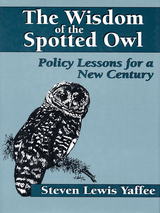 The Wisdom of the Spotted Owl: Policy Lessons For A New Century
Steven Lewis Yaffee
Island Press, 1994 The controversy over the management of national forests in the Pacific Northwest vividly demonstrates the shortcomings of existing management institutions and natural resource policies. The Wisdom of the Spotted Owl explores the American policymaking process through the case of the spotted owl -- a case that offers a striking illustration of the failure of our society to cope with long-term, science-intensive issues requiring collective choices. Steven Lewis Yaffee analyzes the political and organizational dynamics from which the controversy emerged and the factors that led to our stunning inability to solve it. He examines the state of resource management agencies and policy processes, providing insight into questions such as: - What caused the extreme polarization of opinion and lack of communication throughout the 1980s and early 1990s?
- How can the inadequate response of government agencies and the failure of the decisionmaking process be explained?
- What kinds of changes must be made to enable our resource policy institutions to better deal with critical environmental issues of the 1990s and beyond?
By outlining a set of needed reforms, the book will assist those who are involved in re-creating natural resource agencies and public policy processes for the challenges of the next century. In explaining the policymaking process -- its realities and idiosyncrasies -- The Wisdom of the Spotted Owl provides a framework for understanding policies and institutions, and presents a prescription for change to allow for more effective handling of current and future environmental problems.
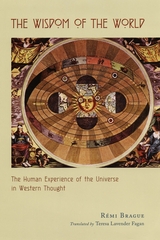 The Wisdom of the World: The Human Experience of the Universe in Western Thought
Rémi Brague
University of Chicago Press, 2003 When the ancient Greeks looked up into the heavens, they saw not just sun and moon, stars and planets, but a complete, coherent universe, a model of the Good that could serve as a guide to a better life. How this view of the world came to be, and how we lost it (or turned away from it) on the way to becoming modern, make for a fascinating story, told in a highly accessible manner by Rémi Brague in this wide-ranging cultural history.
Before the Greeks, people thought human action was required to maintain the order of the universe and so conducted rituals and sacrifices to renew and restore it. But beginning with the Hellenic Age, the universe came to be seen as existing quite apart from human action and possessing, therefore, a kind of wisdom that humanity did not. Wearing his remarkable erudition lightly, Brague traces the many ways this universal wisdom has been interpreted over the centuries, from the time of ancient Egypt to the modern era. Socratic and Muslim philosophers, Christian theologians and Jewish Kabbalists all believed that questions about the workings of the world and the meaning of life were closely intertwined and that an understanding of cosmology was crucial to making sense of human ethics. Exploring the fate of this concept in the modern day, Brague shows how modernity stripped the universe of its sacred and philosophical wisdom, transforming it into an ethically indifferent entity that no longer serves as a model for human morality.
Encyclopedic and yet intimate, The Wisdom of the World offers the best sort of history: broad, learned, and completely compelling. Brague opens a window onto systems of thought radically different from our own.
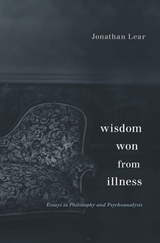 Wisdom Won from Illness: Essays in Philosophy and Psychoanalysis
Jonathan Lear
Harvard University Press, 2017 Wisdom Won from Illness brings into conversation two fields of humane inquiry—psychoanalysis and moral philosophy—that seem to have little to say to each other but which, taken together, form a basis for engaged ethical thought about how to live.
Jonathan Lear begins by looking to the ancient Greek philosophers for insight into what constitutes the life well lived. Socrates said the human psyche should be ruled by reason, and much philosophy as well as psychology hangs on what he meant. For Aristotle, reason organized and presided over the harmonious soul; a wise person is someone capable of a full, happy, and healthy existence. Freud, plumbing the depths of unconscious desires and pre-linguistic thoughts, revealed just how unharmonious the psyche could be. Attuned to the stresses of modern existence, he investigated the myriad ways people fall ill and fail to thrive. Yet he inherited from Plato and Aristotle a key insight: that the irrational part of the soul is not simply opposed to reason. It is a different manner of thinking: a creative intelligence that distorts what it seeks to understand.
Can reason absorb the psyche’s nonrational elements into a whole conception of the flourishing, fully realized human being? Without a good answer to that question, Lear says, philosophy is cut from its moorings in human life. Wisdom Won from Illness illuminates the role of literature in shaping ethical thought about nonrational aspects of the mind, offering rich readings of Shakespeare, Kierkegaard, J. M. Coetzee, Marilynne Robinson, and others.
|
|
